The Samsung QN70F is quite a decent mid-range television. Its strongest feature is definitely the smoothness of the image – thanks to the 144 Hz panel, low input lag, and a wealth of gamer features, we have here a recipe for nearly the perfect gaming display. It will also perform well for sports fans – the picture is fast, clear, and nothing tears. When it comes to picture quality – it's really not bad. The VA panel offers good black levels, brightness is better than average, and colors look great after calibration. Samsung advertises the QN70F as Neo QLED, meaning Mini LED, and in a certain sense, one can view it that way – but only partially. The backlighting is edge-lit, so it falls short of true Mini LEDs with local dimming. It's a shame because marketing does its job, and the user might feel a bit misled. Additionally, there are some small shortcomings – no USB recording, no DTS support. But despite everything, the QN70F makes a really good impression. It may not be a "true" Mini LED, but for its price, it's a solid piece of television – especially for gamers and anyone who enjoys fast, dynamic content.
- Matching (Score)
- Our verdict
- TV appearance
- Where to buy
- Contrast and black detail
- HDR effect quality
- Factory color reproduction
- Color reproduction after calibration
- Smoothness of tonal transitions
- Image scaling and smoothness of tonal transitions
- Blur and motion smoothness
- Console compatibility and gaming features
- Input lag
- Compatibility with PC
- Viewing angles
- TV efficiency during daytime
- Details about the matrix
- TV features
- Apps
- Playing files from USB
- Sound
Samsung Neo QLED QN70F / QN74F / QN77F vs Hisense E8Q
Direct compare
Check the best price offer:
Samsung Neo QLED QN70F / QN74F / QN77FQN70F / QN74F / QN77F
E8Q
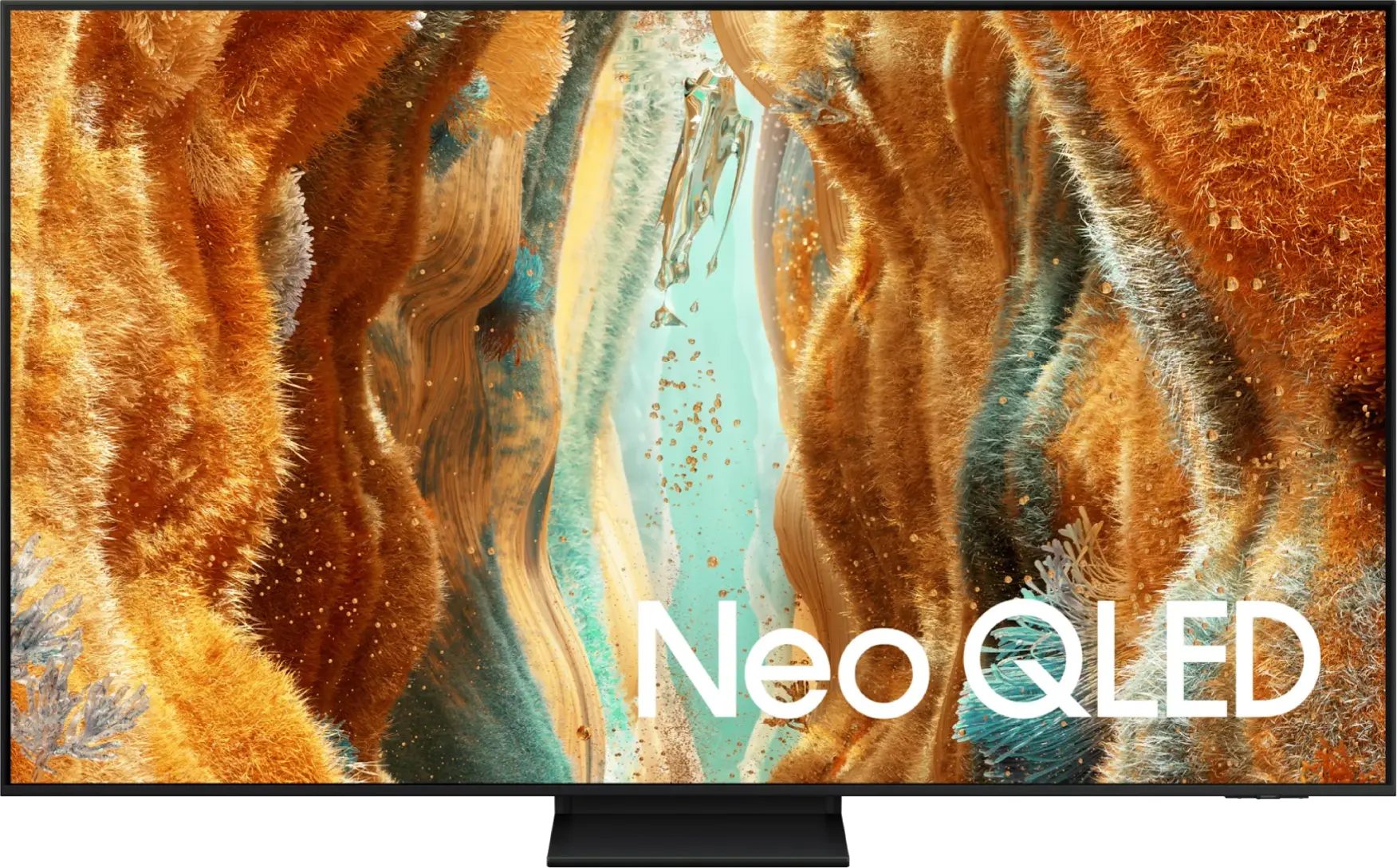
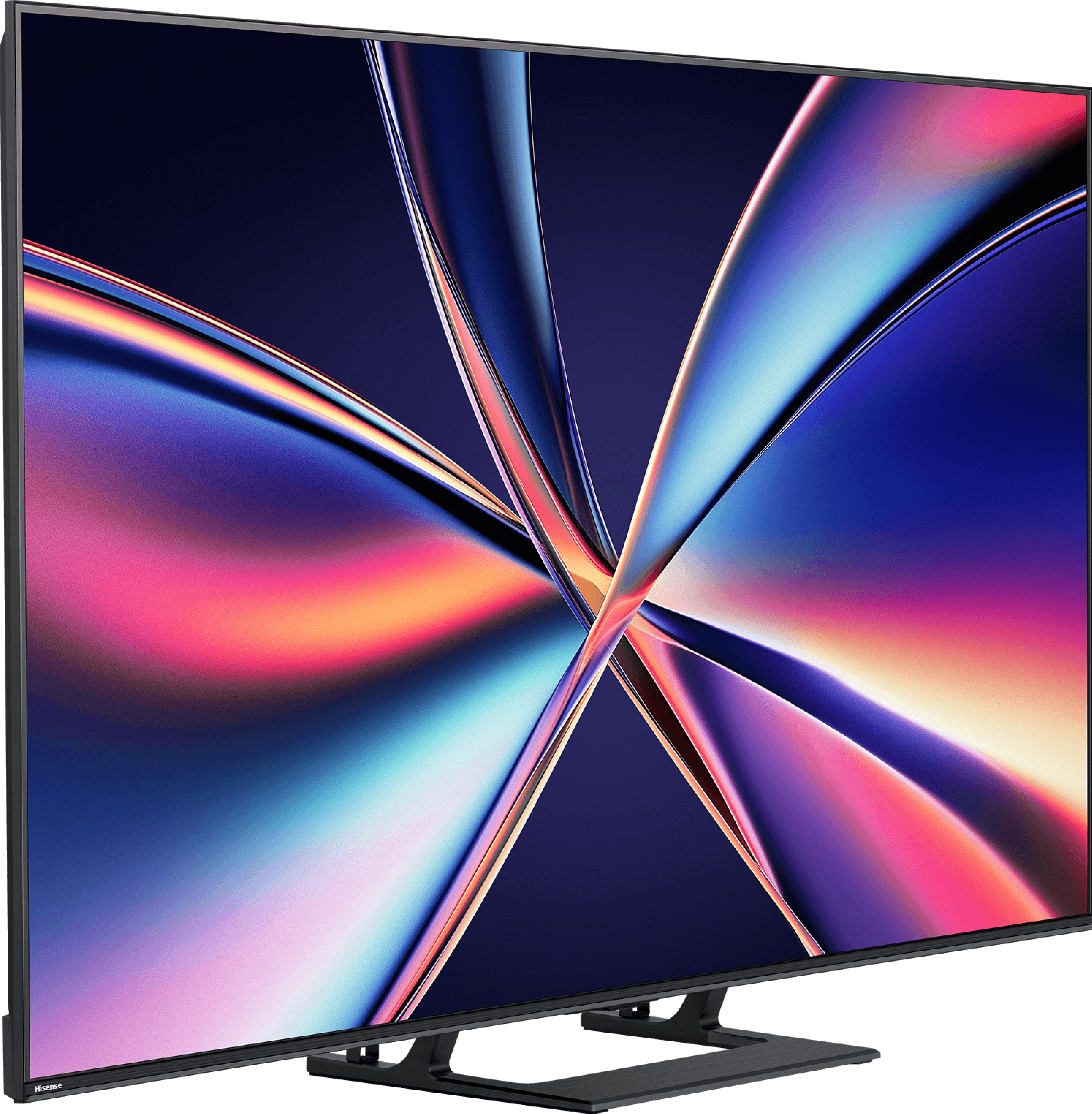
Panel type: LCD VA
Resolution: 3840x2160
System: Tizen
Model year: 2025
Complete the survey to find out the result

Panel type: LCD VA
Resolution: 3840x2160
System: VIDAA
Model year: 2025
Complete the survey to find out the result

Overall rating
7.1
7.0
Movies and series in UHD quality
6.5
6.7
Classic TV, YouTube
6.5
6.8
Sports broadcasts (TV and apps)
6.7
6.5
Gaming on console
8.5
8.0
TV as a computer monitor
8.2
8.6
Watching in bright light
6.3
6.2
Utility functions
7.5
8.9
Apps
8.7
7.7
Sound quality
6.4
5.5
Complete the survey to find out what fits your preferences
Advantages
Nice black and contrast
Above average panel brightness
High refresh rate of 144Hz
Many features for gamers: ALLM, VRR, Game Bar, etc.
Low input lag
4 HDMI 2.1 ports
Extensive and smooth Tizen operating system
Super slim design
Great contrast and deep black
Very good fluidity of tonal transitions (close to reference level)
High brightness
Support for 4K 144 Hz and even 240 Hz in Full HD
VRR, ALLM, G-SYNC – a complete package for gamers
Low input lag
Many classic TV features built into the VIDAA system
Disadvantages
No USB recording function
No DTS format
Issues with the HGIG function (for gamers)
Symbolic local dimming (Is this really MINI-LED?)
No support for HGiG (makes HDR setup difficult on consoles)
U7Q
Our verdict
The Hisense E8Q is a television that clearly draws heavily from the U7Q model – and that's a good thing. After all, it is its European version, not another "diet" mutation. Just a few moments with this screen reveal that the E8Q is trying to impress. And in many ways, it really succeeds. Right off the bat – what stands out: the black is deep, the contrast is high, and the brightness exceeds the threshold that we can simply call satisfying. Let's add to that almost perfect smoothness in tonal transitions, and we have an image that looks very mature, especially for this price segment. In gaming? Just as good. It supports VRR, ALLM, 144 Hz in 4K, and even 240 Hz in Full HD – it's hard to find fault here. Well… almost. Because the E8Q has one additional flaw compared to the U7Q – the sound. In our unit, even at moderate volume levels, the back of the casing started to resonate, generating quite unpleasant crackling noises. This might be a flaw in the test sample, but since the U7Q simply performed better – it's worth noting. Especially if you find both models at a similar price. We can confidently state that the E8Q is a television that can boldly compete for the attention of those looking for a quality Mini-LED at a reasonable price. If a good deal comes along, it's definitely worth it – because we get almost the same as with the U7Q. And that means a really solid picture, excellent gaming features, and overall very good equipment that you can stick with for a long time.
TV appearance
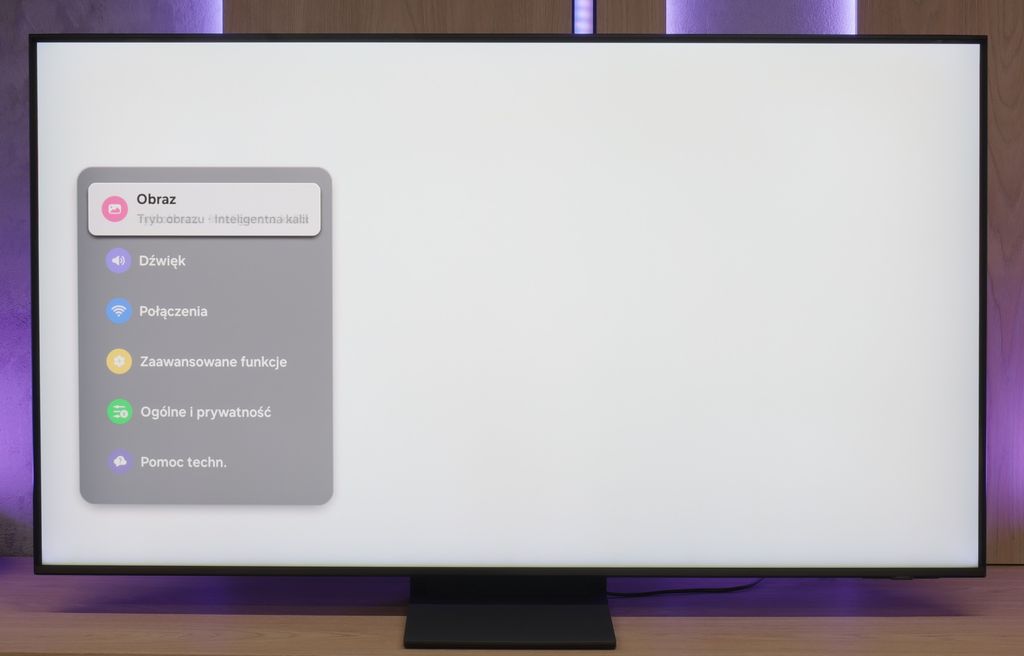
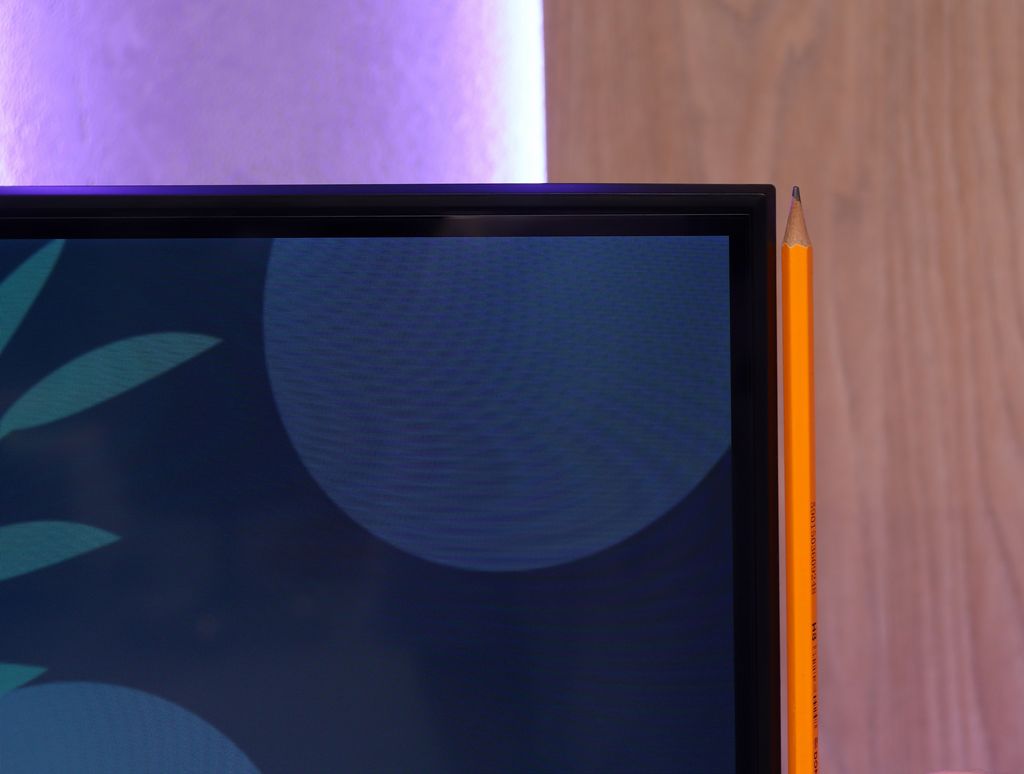
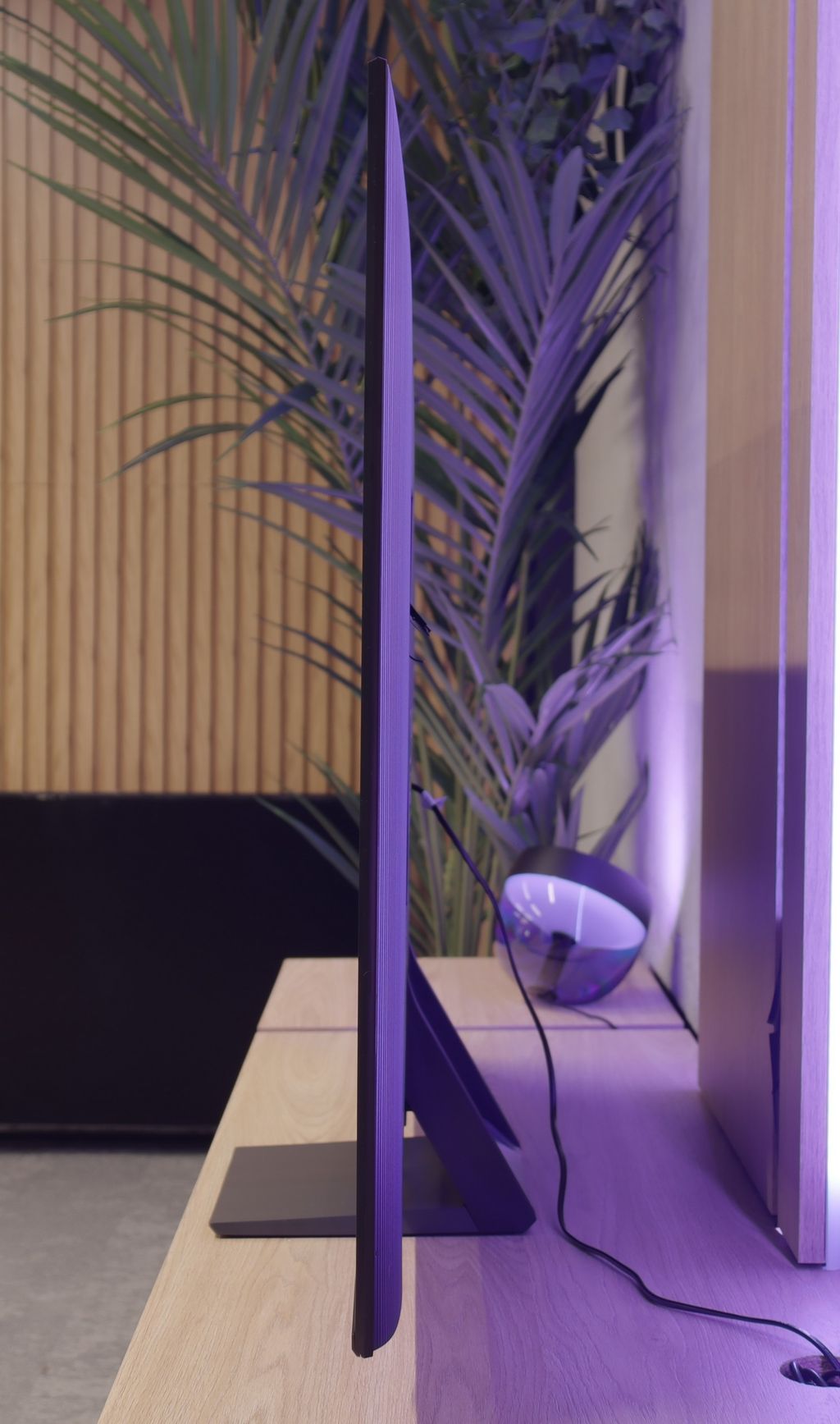
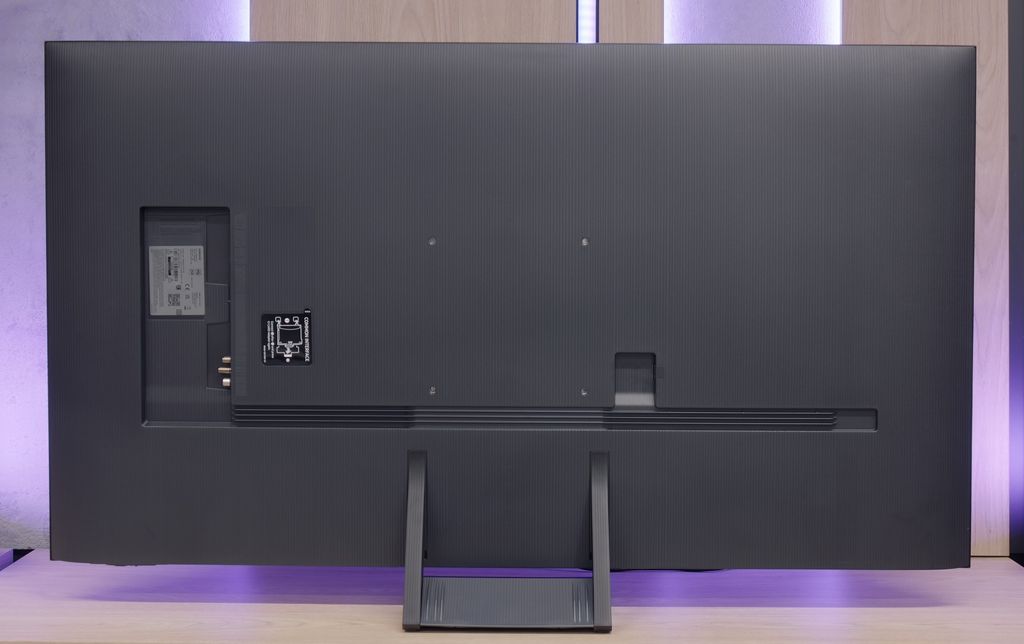
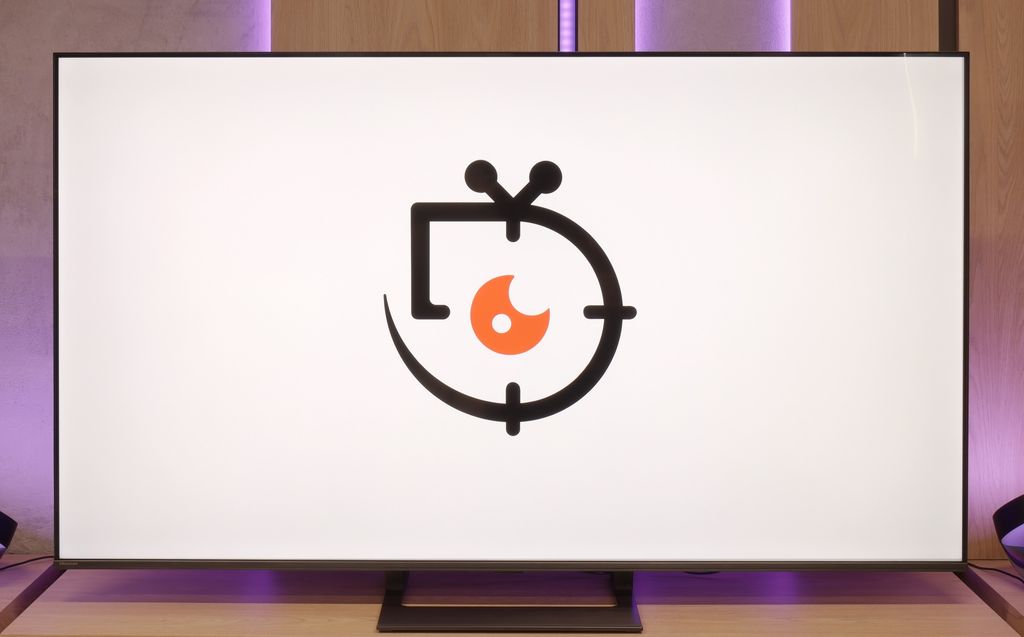
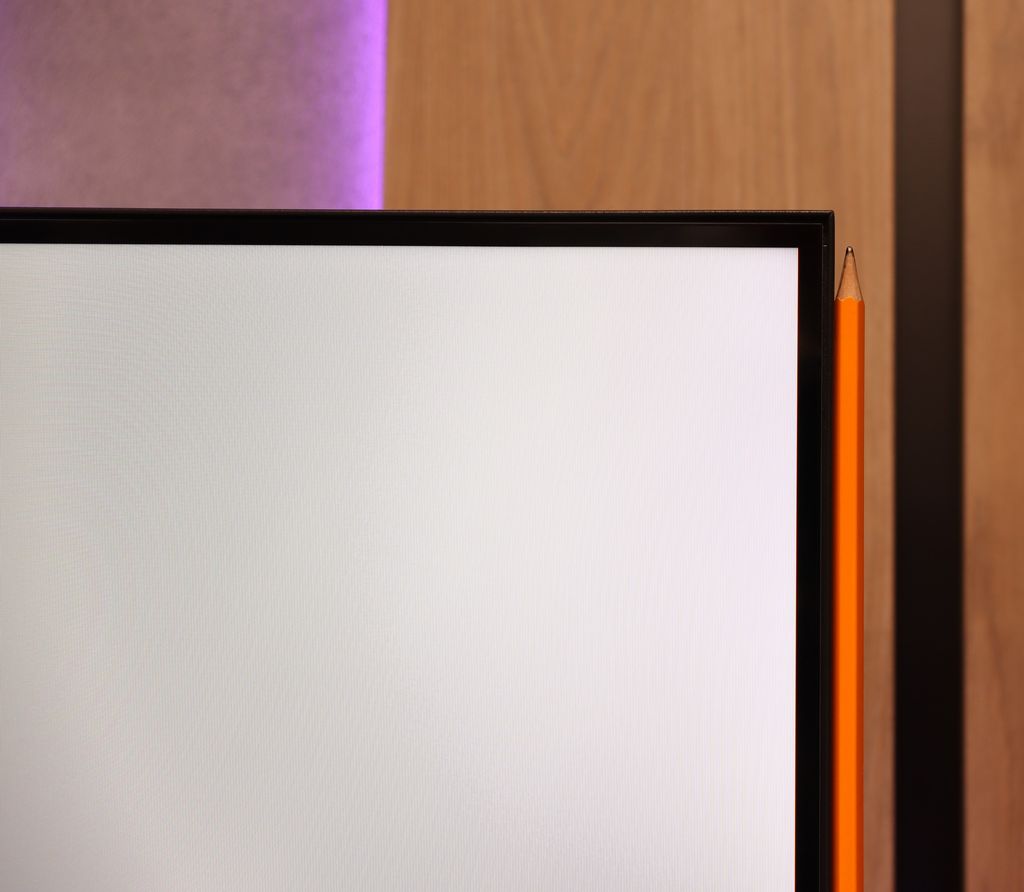
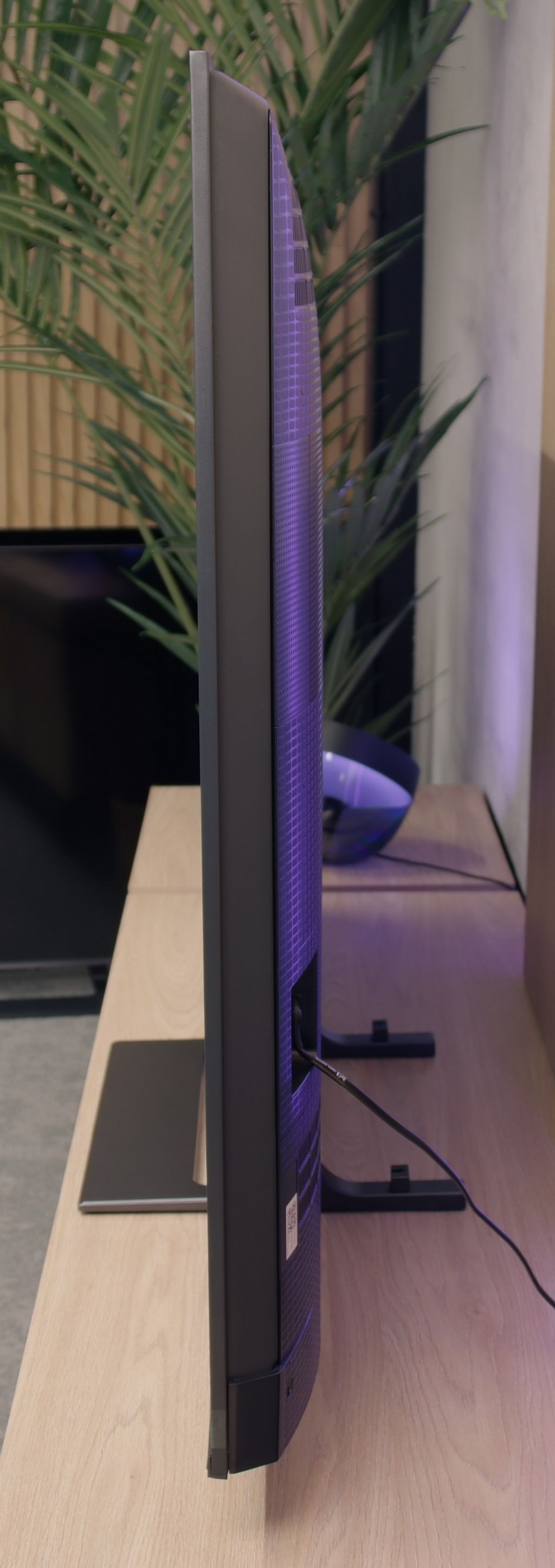
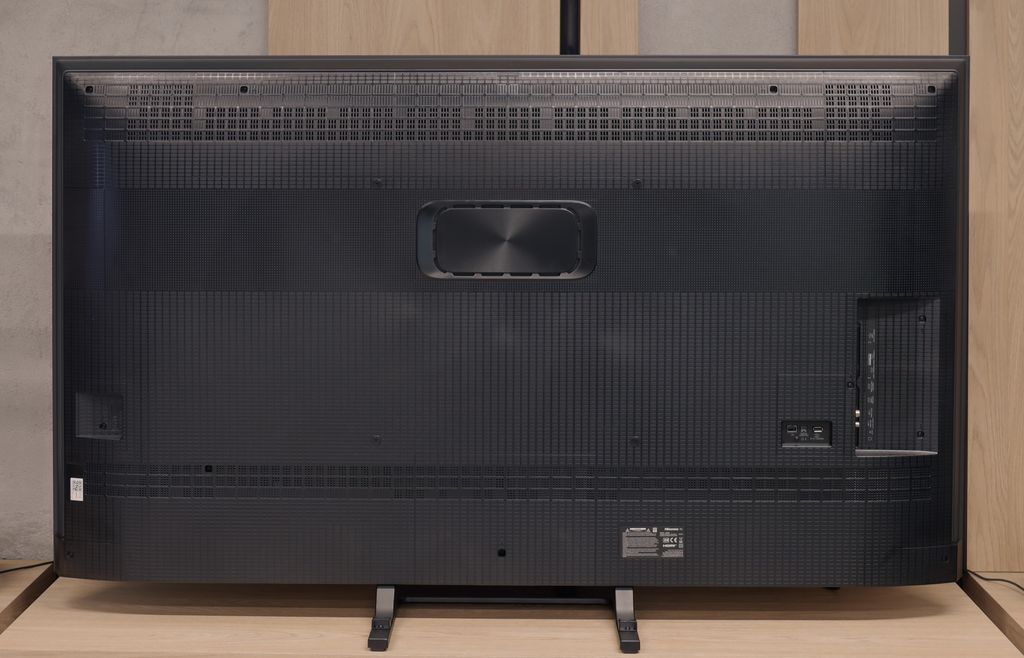
Contrast and black detail
6.2/10
7.6/10
Local dimming function: Yes, number of zones: 20 (1 x 20)
Local dimming function: Yes, number of zones: 220 (10 x 22)
Contrast:

Result
9,200:1

Result
7,000:1

Result
5,350:1

Result
5,700:1

Result
5,300:1

Result
277,000:1

Result
43,700:1

Result
15,750:1

Result
8,850:1

Result
6,350:1
Halo effect and black detail visibility:

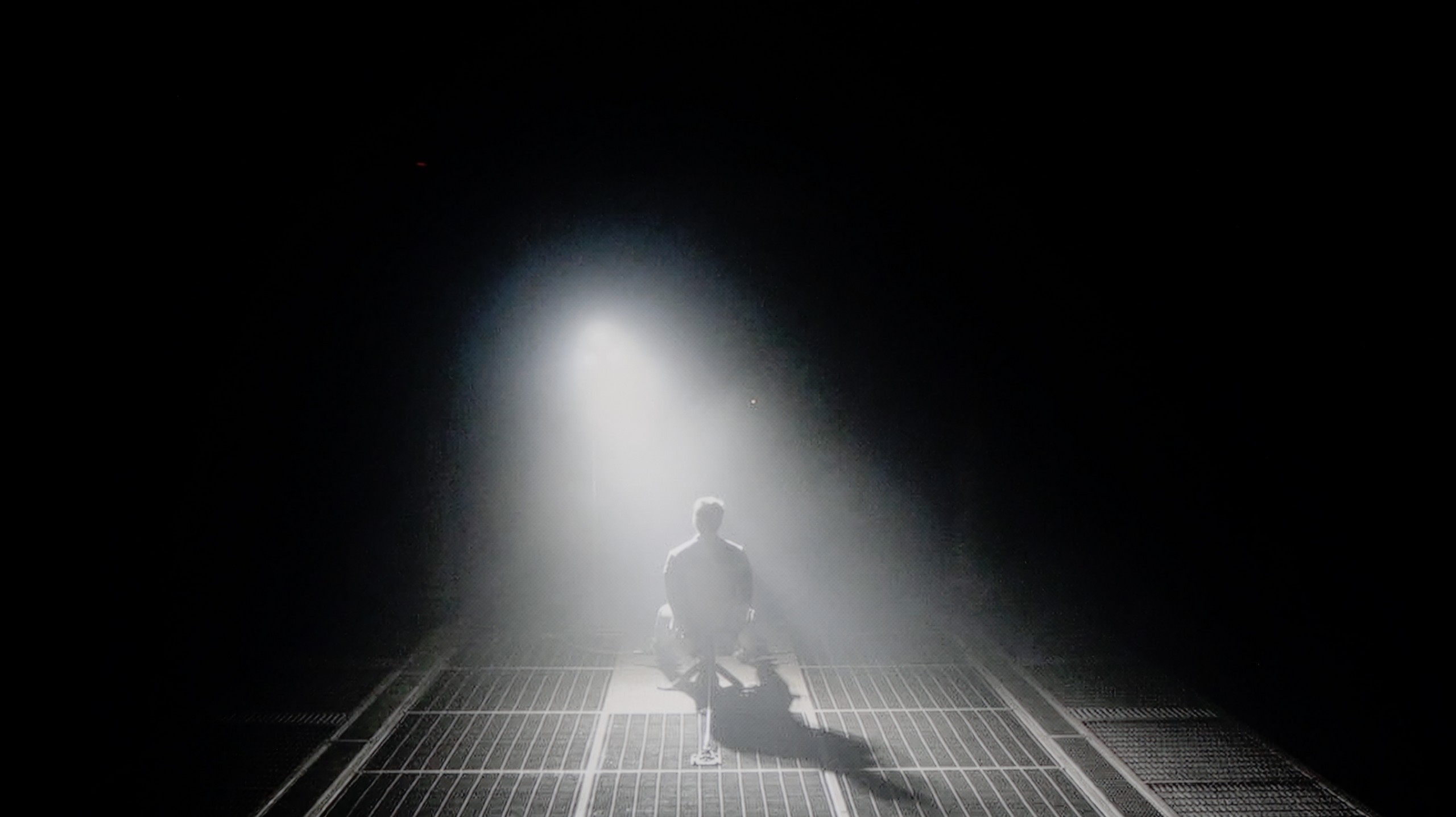
The QN70F is equipped with a VA panel that offers high native contrast – this is already a good starting point for blacks, especially for evening viewing. But theoretically, this does not end its capabilities. The television is branded as Neo QLED, which means the presence of Mini LED technology and a local dimming system. And indeed – the QN70F has such a function. The problem is that we are not talking about classical local dimming with LEDs placed directly behind the panel. Instead, edge lighting is used with a full-screen dimming mechanism known as global dimming. The effect of this is that instead of selective brightness control in individual zones, the entire screen is slightly dimmed when a dark scene appears. In practice, this means that the contrast is average compared to Mini LED models that offer true local dimming. The black level is not bad – it's thanks to the VA panel itself – but we cannot speak of precise light control that advanced systems with multiple zones provide. And here comes the question: is the QN70F series television really a Mini LED TV, or just a marketing variation on the Q70 series? Looking at the technical aspects – it is hard to consider this model a full-fledged representative of this technology. However, in everyday use, the black level looks decent and may be fully satisfying for many people.
Similarly to the U7Q, the E8Q model uses a VA panel and Mini-LED backlighting. The number of dimming zones also remains at a very similar level – in the 65-inch variant we tested, we counted 220 zones, which is exactly the same as in the U7Q. On paper, this looks really good for this price segment, but even better – in practice. The contrast is high, and black can be really deep. In many scenes, the lights are clearly separated, and the image gains in spaciousness. This is one of those cases where Mini-LED shows it can approach the quality of OLEDs – provided that we are aware of the limitations we need to consider. In very difficult scenes, there may be slight lightening or minor halo effects around bright objects, but these are phenomena typical of this technology and are not very noticeable. Ultimately – the contrast and blacks in the E8Q are really solid, almost identical to those in the U7Q model. It’s hard to find fault with this, especially when we look at the price of the television.
HDR effect quality
5.6/10
4.5/10
Luminance measurements in HDR:

Result
619 nit

Result
449 nit

Result
500 nit

Result
422 nit

Result
483 nit

Result
531 nit

Result
148 nit

Result
320 nit

Result
100 nit

Result
625 nit
Scene from the movie “Pan” (about 2800 nits)


Scene from the movie “Billy Lynn” (about 1100 nits)


Static HDR10


Dynamic: HDR10+
Dynamic: Dolby Vision


HDR luminance chart:
Hisense E8Q
Luminancja HDR
Luminance of RGB colors
Samsung Neo QLED QN70F / QN74F / QN77F
Luminancja HDR
Luminance of RGB colors
QN70F is a TV that can positively surprise when it comes to brightness. In ideal test conditions, it reaches even 800 nits, which – for this price range – is really solid. Of course, that's a result from measurement test patterns, so we decided to check how it performs in practice, with real movies. Here, the TV somewhat tones down its capabilities. In most of the tested scenes – for example, in "The Meg" – the actual HDR brightness was around 500 nits. That's still a good result that allows you to enjoy HDR effects, although it is far from perfect. On the other hand, we have a QLED screen with a quantum dot layer, which means very good color reproduction capabilities. The colors are vivid and saturated. QN70F covers about 94% of the DCI-P3 color space, and in the wider BT.2020 gamut, it exceeds 75%, so in this regard, there's nothing to be ashamed of.
Since the E8Q is a twin of the U7Q, it’s no surprise that the quality of the HDR effect is almost identical. On paper, it looks promising – a peak brightness of 800 nits can impress in many scenes. Fragments like the flashes of light in “The Meg” or shots of the sun in “Life of Pi” can indeed evoke a “wow” effect. But the longer we watch, the more we notice the limitations. The problem arises when small, bright details are supposed to be displayed on a dark background. In such situations, the dimming algorithms try to preserve contrast but end up dimming what should shine the brightest. Instead of dazzling details, we get almost invisible points of light. This is typical for Mini-LED in this price segment and is not surprising – but it’s worth knowing that the HDR effect won't always be fully preserved. Fortunately, the color reproduction offers reasons to be satisfied. A coverage of the DCI-P3 color gamut at around 94% is a very good result, and the applied quantum dot layer (more specifically, PFS) does its job – colors are saturated and vibrant, especially with 4K content.
Factory color reproduction
7/10
6.5/10


Factory Mode
After calibration
We tested the QN70F in the best default picture mode, which is Filmmaker Mode. It must be said that in this particular test unit, the factory settings performed quite well. The picture was calm, natural, and despite minor deviations, pleasant to perceive. The biggest flaw was a slight dominance of red in the white balance, which caused a slight pinkish tint to the entire scene. However, this was not a glaring flaw – rather subtle and only noticeable when directly compared to a properly calibrated screen. A somewhat larger issue appeared in the brightness characteristic. The television tends to understate the brightness of parts of the image that should be displayed more brightly. As a result, some details can appear slightly dimmed – not so much lost entirely, but not as clearly pronounced as they should be. Nevertheless, as far as a television in this category and in these settings goes, we consider the result to be a good starting point for further calibration.
Testing the Hisense E8Q in Filmmaker mode, we were hoping for a neutral image close to the director's vision. Unfortunately - although on paper it doesn't look bad (the color reproduction errors are not significant), in practice the image feels somewhat unnatural. The reason? Too strong an increase in blue and a lack of red in the white balance. The effect? The scenes look cool, and the white appears slightly bluish. Alongside the U7Q model, we also noticed a specific approach to brightness management here. The brightness reproduction curve for HDR content (EOTF) shows that the TV can significantly dim small, bright elements of the screen to maintain contrast - but sometimes it goes too far. On the other hand, it can excessively brighten larger, very bright parts, which disrupts tonal balance. This is a compromise that may not suit everyone – especially if you want an as faithful image as possible right out of the box.
Color reproduction after calibration
8.5/10
7.4/10




After calibration, the QN70F shows that it can offer a really high level of color reproduction. It nearly perfectly balanced the white point, and the values in the Color Checker test dropped below 3 – that is, below the threshold at which the average eye can perceive differences. The image looks natural, and the colors are accurately represented, without excessive saturation or the coolness known from factory settings. It must be said that Samsung provides very extensive calibration options – not only for enthusiasts but also for professionals. The QN70F takes advantage of this potential and, after proper adjustment, can come close to much more expensive models in terms of color accuracy. The only thing one could still criticize is the brightness characteristics. There is still a tendency to brighten the smallest parts of the image – particularly those that should remain darker. However, this is a design feature of this model, not a calibration error. Despite this, the final effect definitely deserves recognition.
The calibration of the Movie mode brought really good results, especially regarding SDR content. The white balance was successfully adjusted, which gave the image a natural look – it appeared almost reference-level. The colors were well-saturated, and the overall perception of the content improved significantly. Unfortunately, when we moved to HDR materials, the well-known problems from the U7Q model returned. The TV still tends to “do things its own way,” which is evident from the analysis of the EOTF brightness characteristic – despite calibration, the E8Q still dimmed small details in the shadows, while the bright areas of the screen could sometimes be excessively boosted. In practice, this means that in darker scenes, some of the tiniest details could simply disappear. Although it must be admitted that the entire calibration process brought a lot of good, not everything can be circumvented – even with the use of professional tools. The E8Q can impress with its picture, but in HDR content, its design limitations become noticeable, and it is worth keeping this in mind.
Smoothness of tonal transitions
8/10
9.9/10
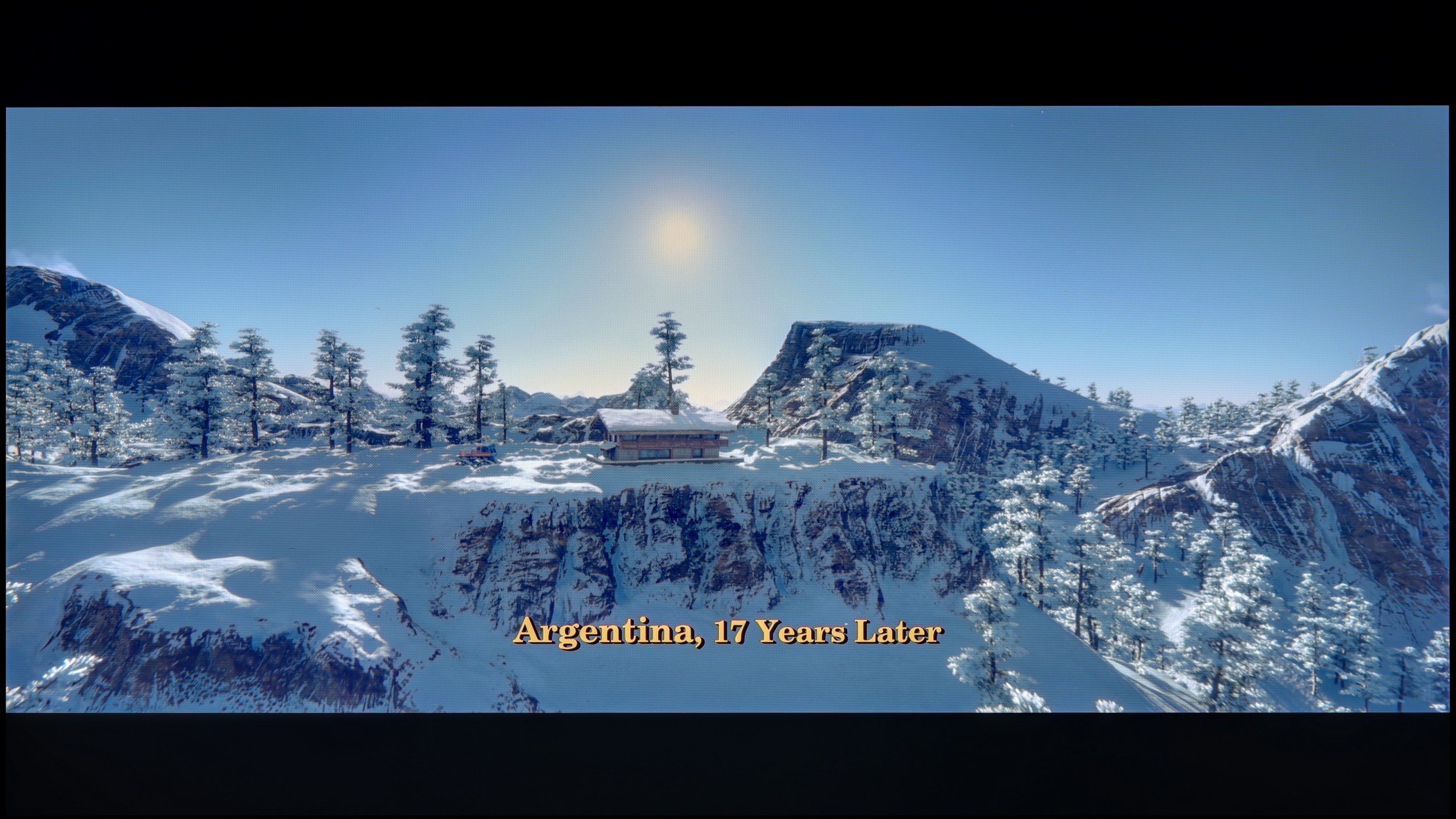






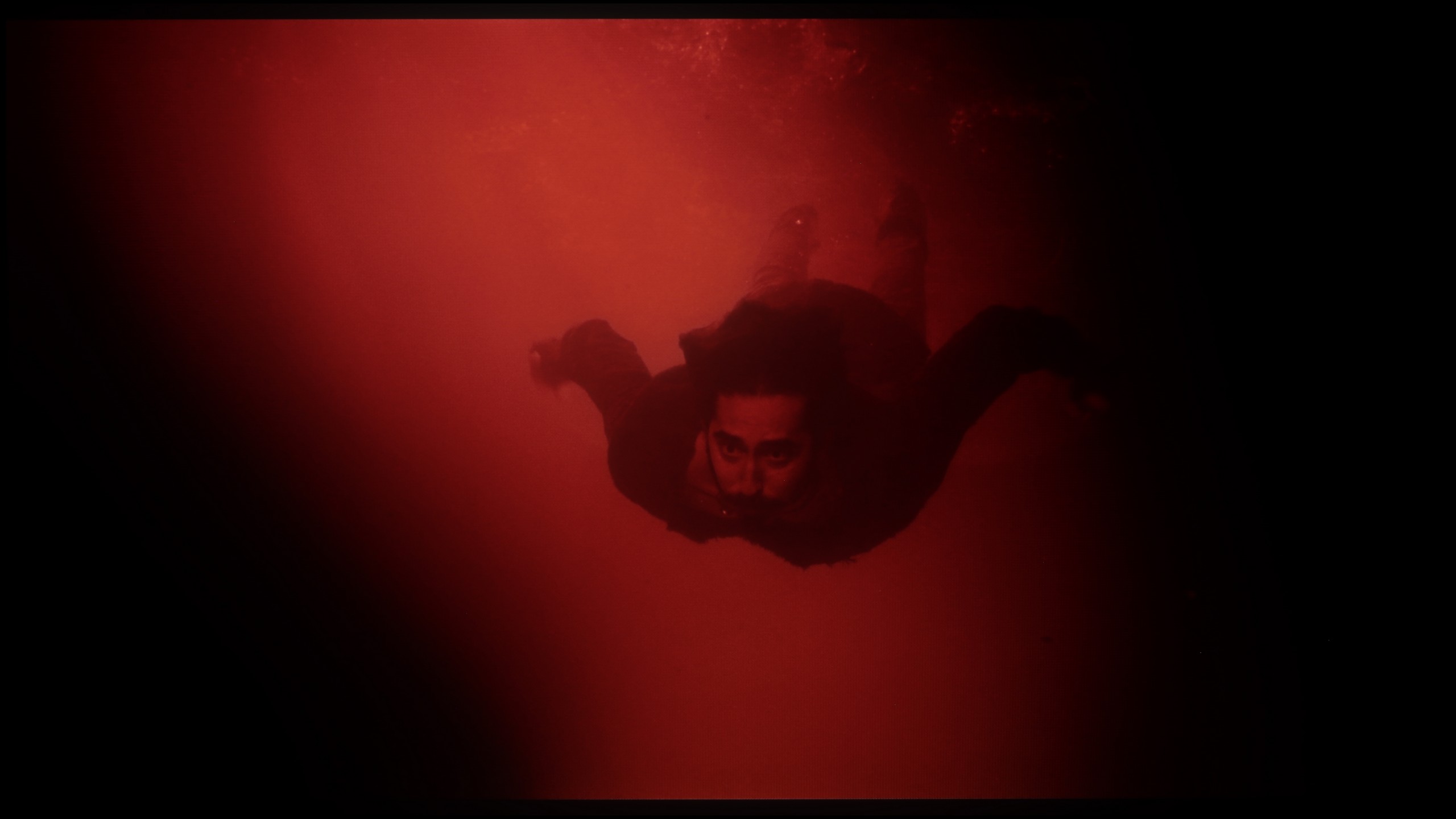




In terms of tonal transition fluidity, the QN70F performs really well. The gradients are smooth, and the colors blend into each other without noticeable thresholds or banding. Even in more challenging film scenes – especially very dark ones – any imperfections are minimal, and you really have to focus to notice them. In everyday viewing, most users should not encounter any issues with color blending. The image looks clean and coherent, without artificial smoothing or distortions. This is another aspect where the QN70F pleasantly surprises.
In this category, the Hisense E8Q truly shows its class. The transitions between colors are very smooth, with no "banding" or clear boundaries between tones. The image looks natural, and the color gradient is exceptionally well-executed – even in more difficult scenes. If there are any minor imperfections, they are subtle enough that they don't stand out. It's hard to find fault here – it looks almost exemplary.
Image scaling and smoothness of tonal transitions
6.9/10
6/10
Smooth transition function
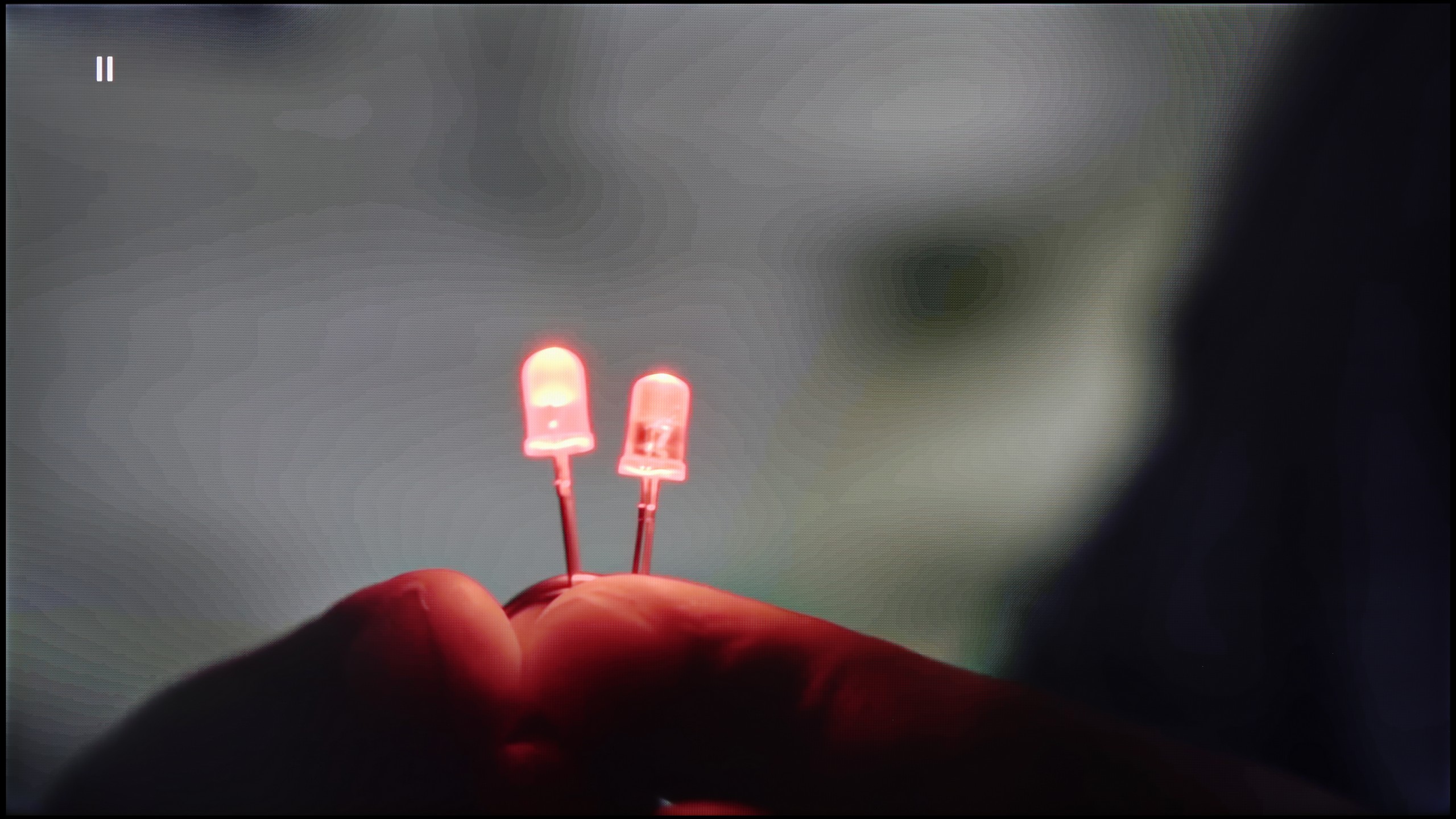

Image without overscan on the SD signal
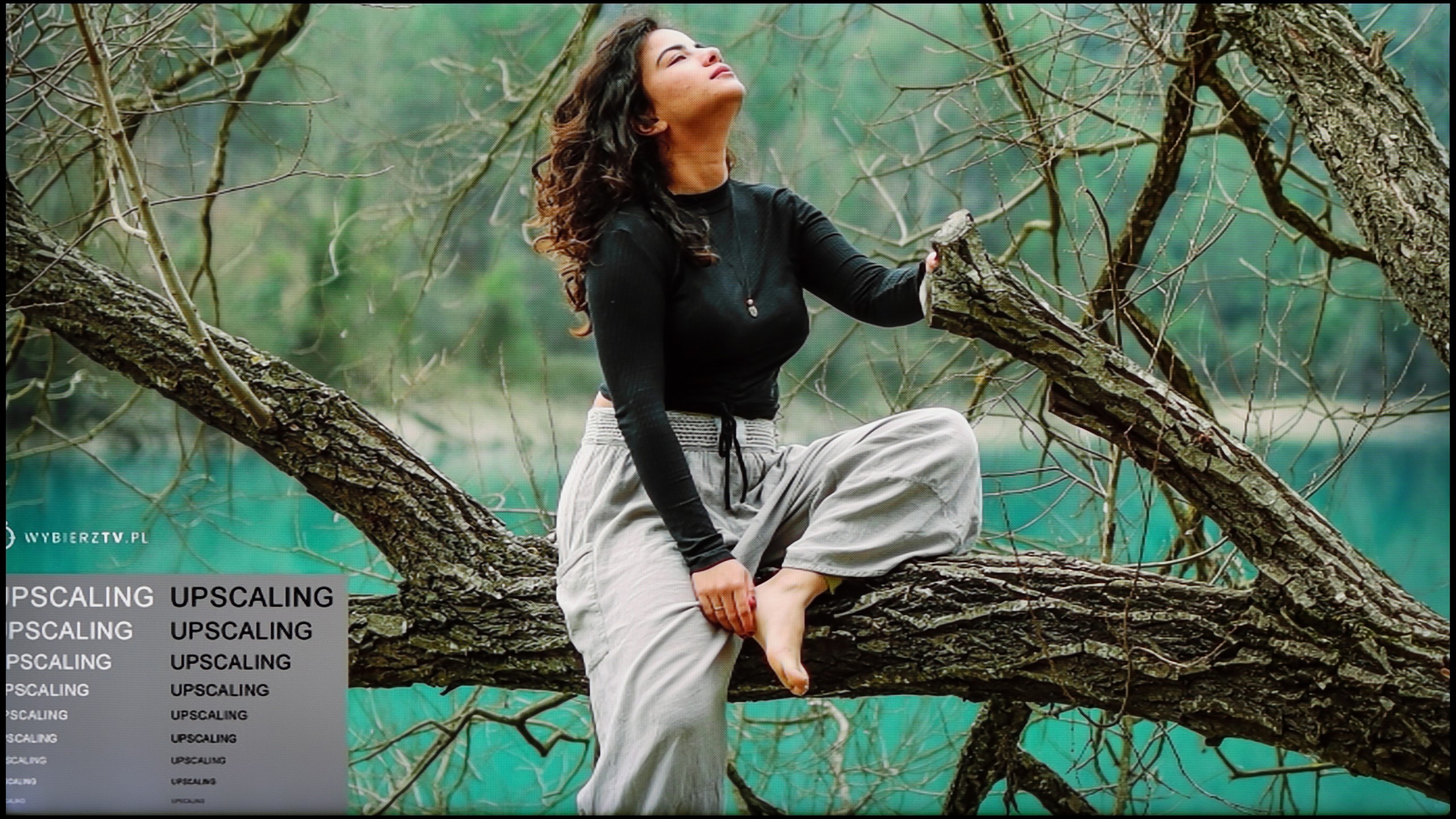

Samsung QN70F offers a distortion reduction feature that improves the smoothness of tonal transitions. In "Standard" mode, it works quite well - smoothing problematic transitions without significantly interfering with the image structure. Film grain is partially removed, but details such as texture or skin structure still remain visible. The "High" mode operates much more aggressively. The smoothing is stronger, but it comes at the cost of a noticeable loss of detail. Therefore, in practice, we recommend sticking with the "Standard" setting or completely turning off this feature. The improvement in gradation may be less spectacular, but the image retains more naturalness.
When it comes to scaling low-quality content, the QN70F performs very well. Tests with lower resolution images were really impressive. Despite slight aliasing of contours, everything looks clean and clear, even if the original content was very poor. It's just a shame that the TV has an overscan issue that cannot be completely turned off. As a result, the image from very low resolution may be slightly cropped, which is mainly visible on subtitles or the interface.
In the case of older materials with lower quality, a gentle smoothing of tonal transitions is often useful. The Hisense E8Q, like the U7Q, has the "Smooth and Gradient Picture" feature, but unfortunately, its effectiveness leaves much to be desired. The “Low” setting is almost imperceptible in operation, while higher settings simply blur details instead of improving transitions. The good news is that the feature does not compromise the film grain, which allows it to maintain the image structure. On the plus side, the scaling is commendable. The television can fairly sensibly transform older content to a higher resolution—without artificially emphasizing contours or excessive sharpening. Though it does not match the best models in this category, it performs quite well for its class.
Blur and motion smoothness
7.5/10
7.5/10
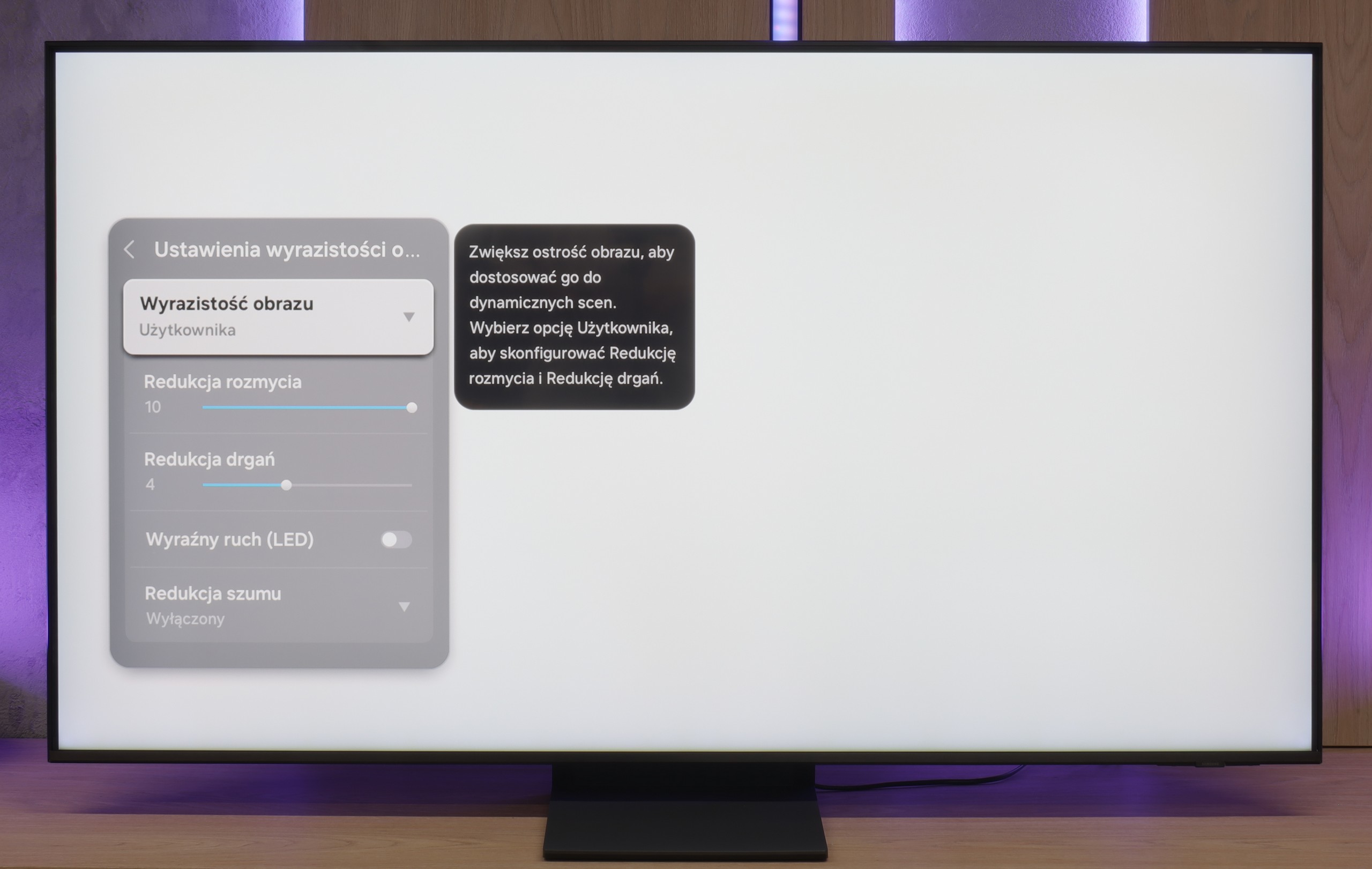

Blur (native resolution, maximum refresh rate):
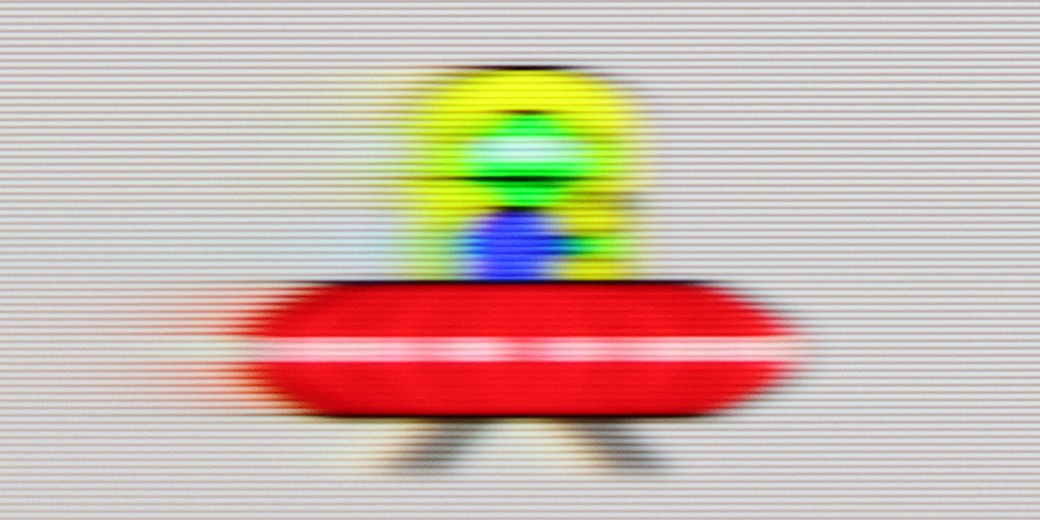
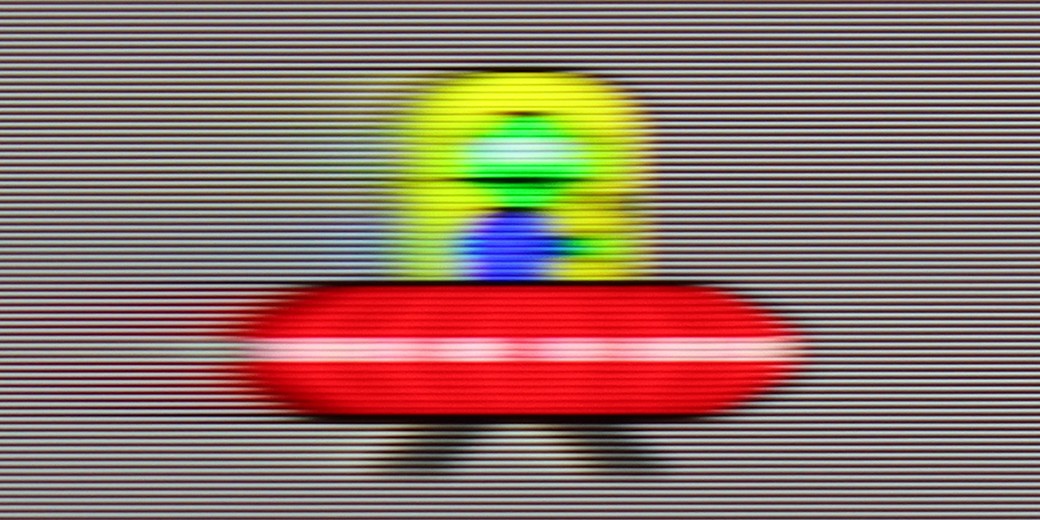
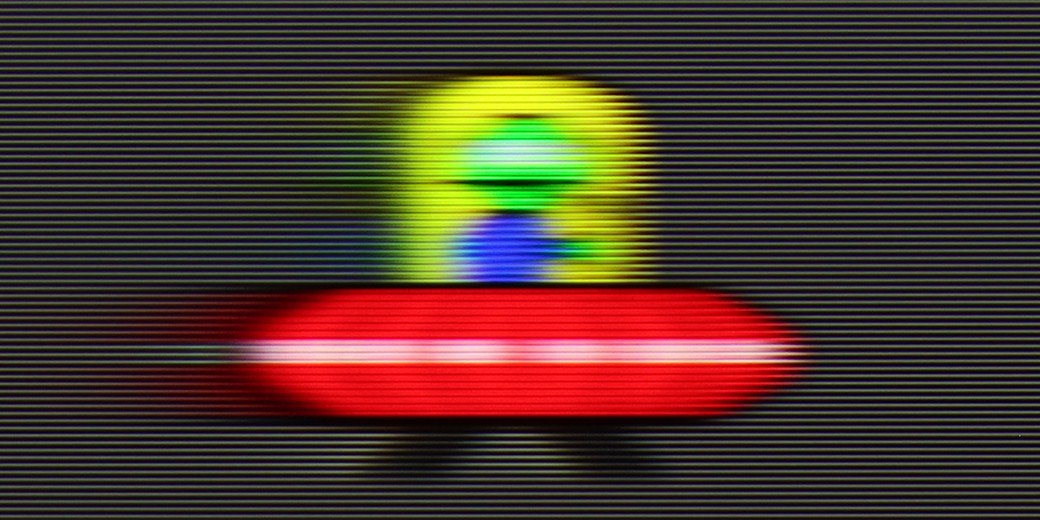
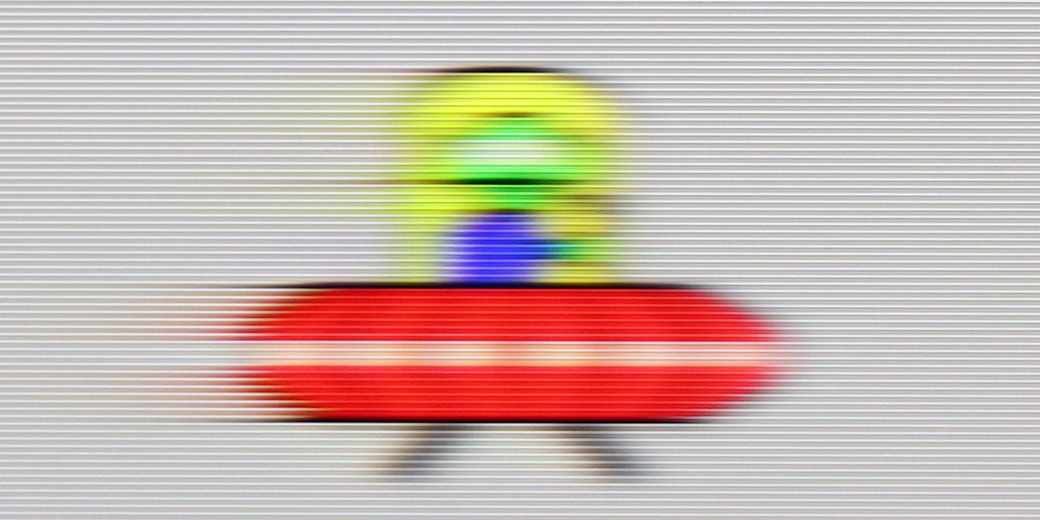
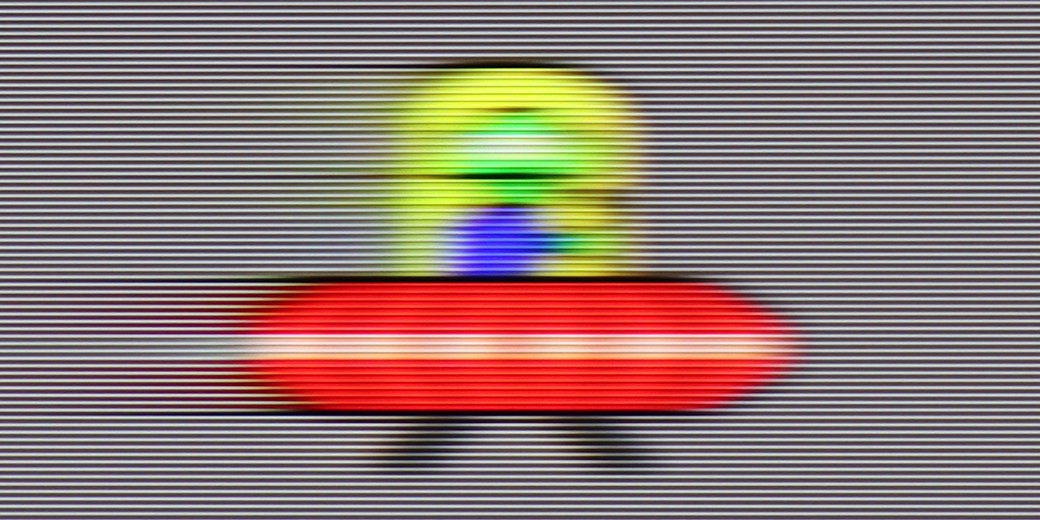
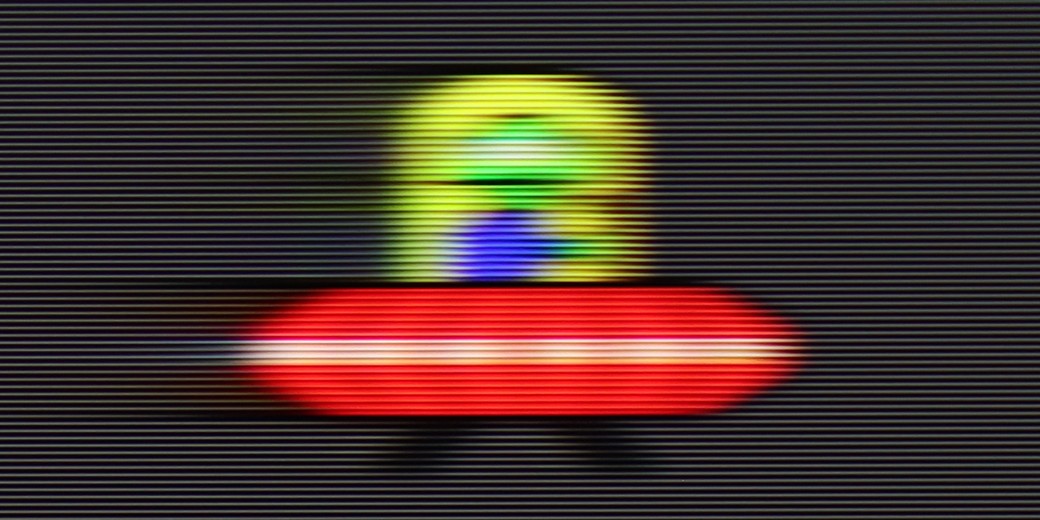
Blur (BFI function enabled):
Image flickers in this mode





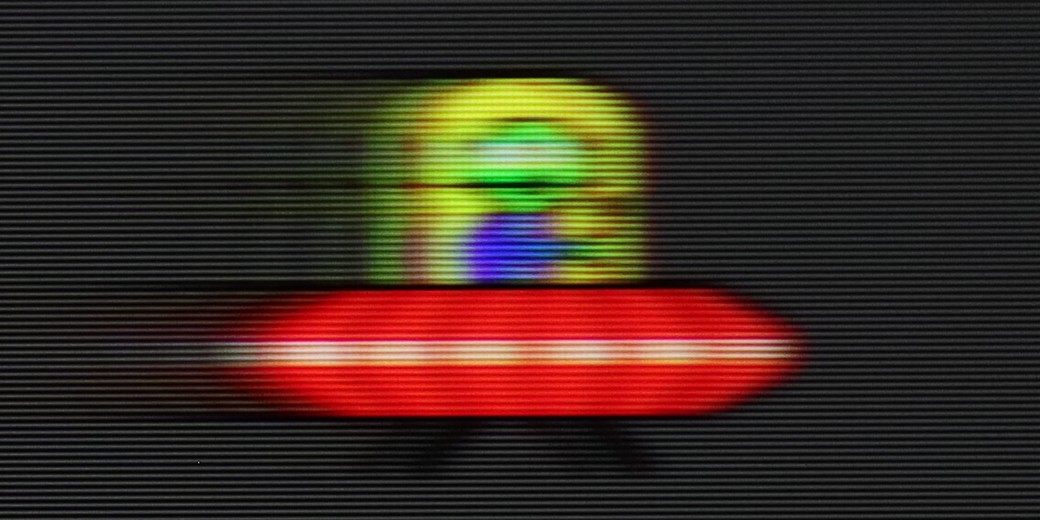
Smużenie (4K 144Hz):
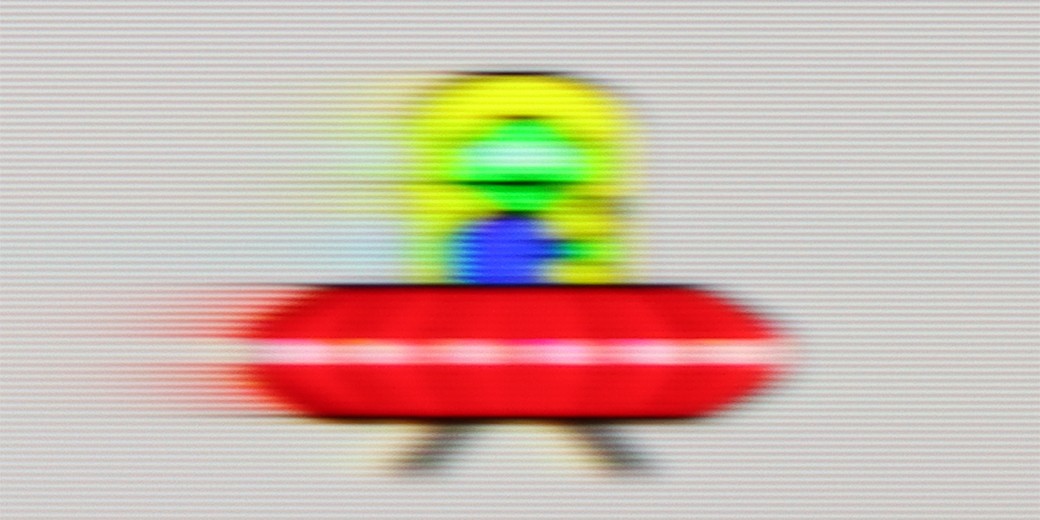
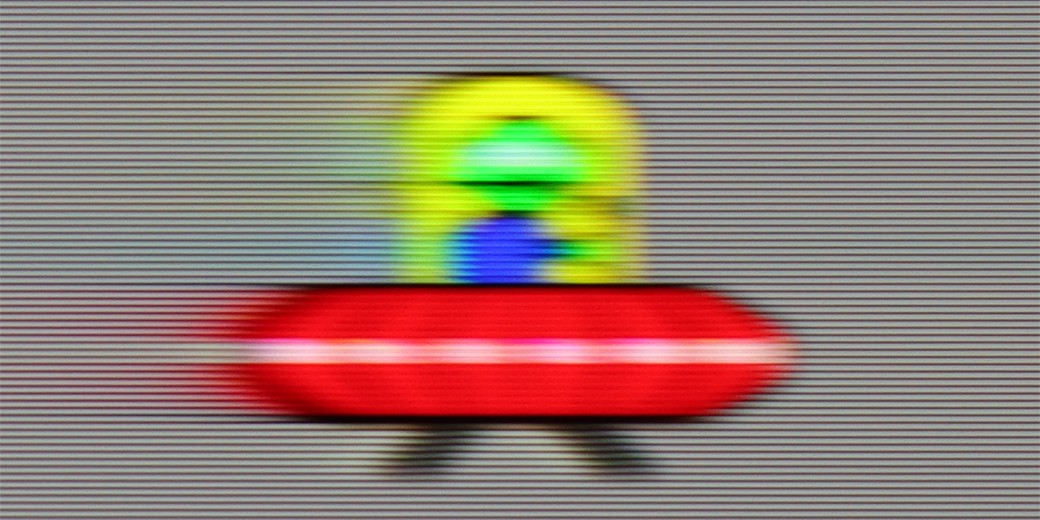
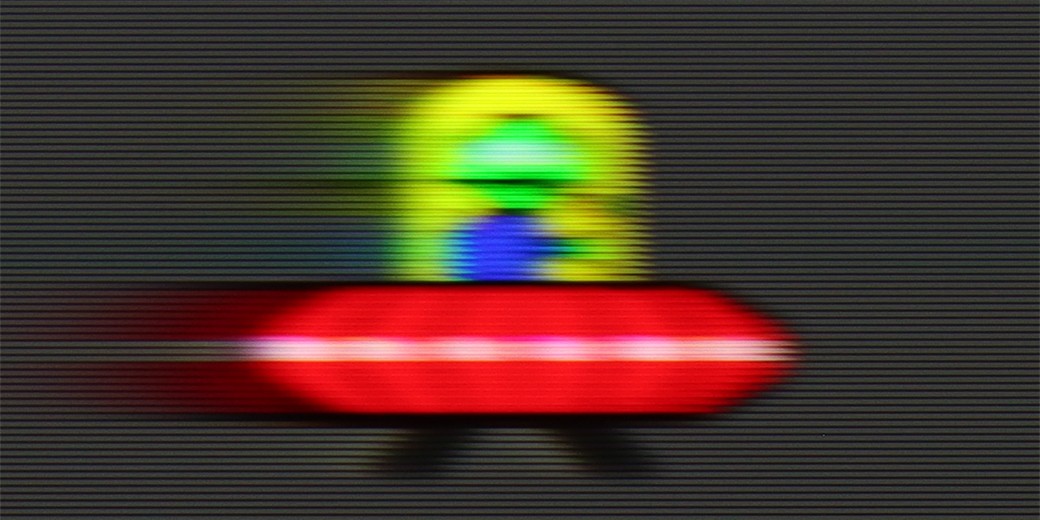
Smużenie (4K 120Hz):
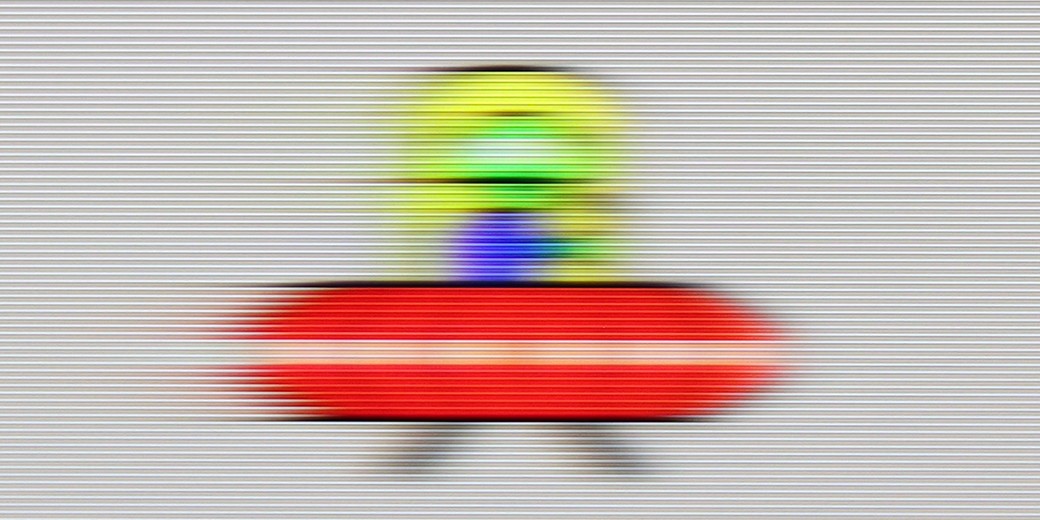
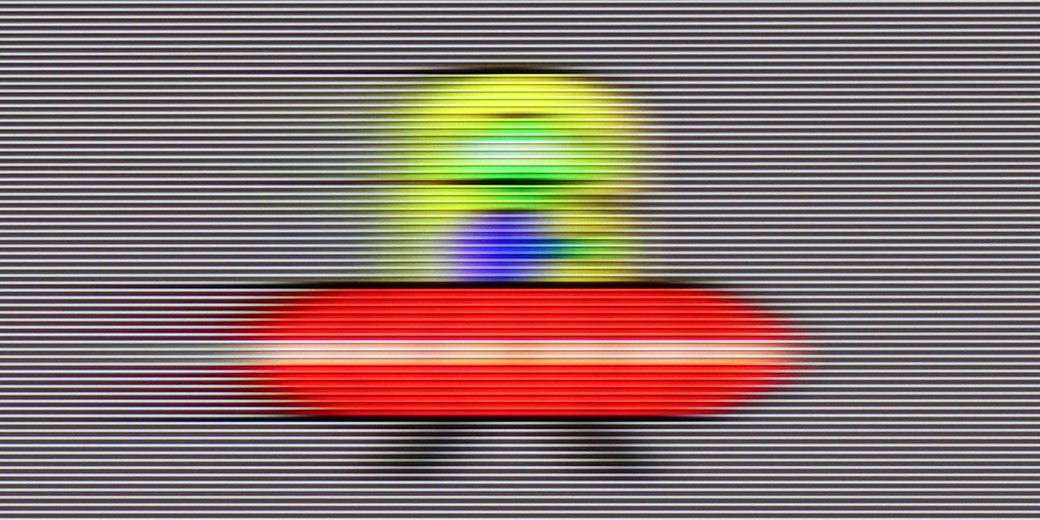
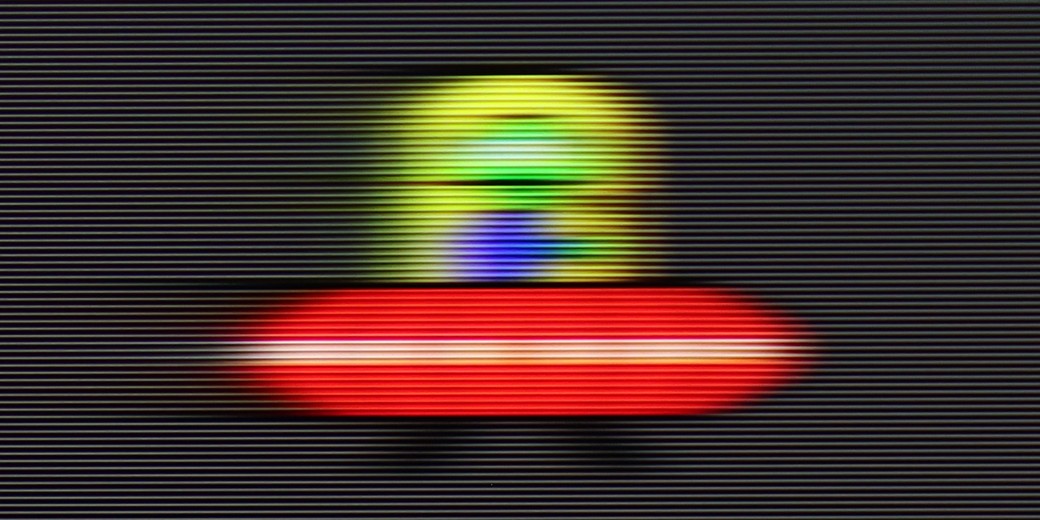
The QN70F is a television with a refresh rate of 144 Hz, which puts it at the forefront in terms of image smoothness. Whether we are watching dynamic sports broadcasts or playing on a console, the picture looks very good. There is no feeling of stuttering, chopping, or the typical "tearing" in fast motion that is common in lower-end models. Samsung also allows you to adjust the smoothness to your own preferences. In the picture clarity settings, we find options such as blur reduction and motion smoothing – each of which can be adjusted independently. This is especially useful when watching content with a lower frame rate and we want to give it a smoother, more cinematic character – or on the contrary, maintain the natural film "feeling" of 24 frames.
Like the U7Q, the E8Q model is a fast television designed for dynamic content. It supports 144 Hz refresh rates in 4K resolution, and if for some reason someone is still gaming in Full HD, it can achieve even 240 Hz. This is a significant advantage, especially for PC users looking for maximum fluidity. In everyday use, the television performs very well. The "Ultra Motion Smoothness" mode provides us with two sliders, allowing for personalized image settings – whether it’s more cinematic with preserved film frames or heavily smoothed, almost "series-like." It’s good that the manufacturer gives a choice here instead of imposing one style. On sports materials, live broadcasts, or in games – motion appears clean and stable. Sure, it’s not at the level of OLEDs, but for this price range, the E8Q performs really well.
Console compatibility and gaming features
8.2/10
8.5/10
- ALLM
- VRR
- VRR range48 - 144Hz48 - 240Hz
- Dolby Vision Game Mode
- Correct implementation of HGIG
- 1080p@120Hz
- 1440p@120Hz
- 4K@120Hz
- Game bar
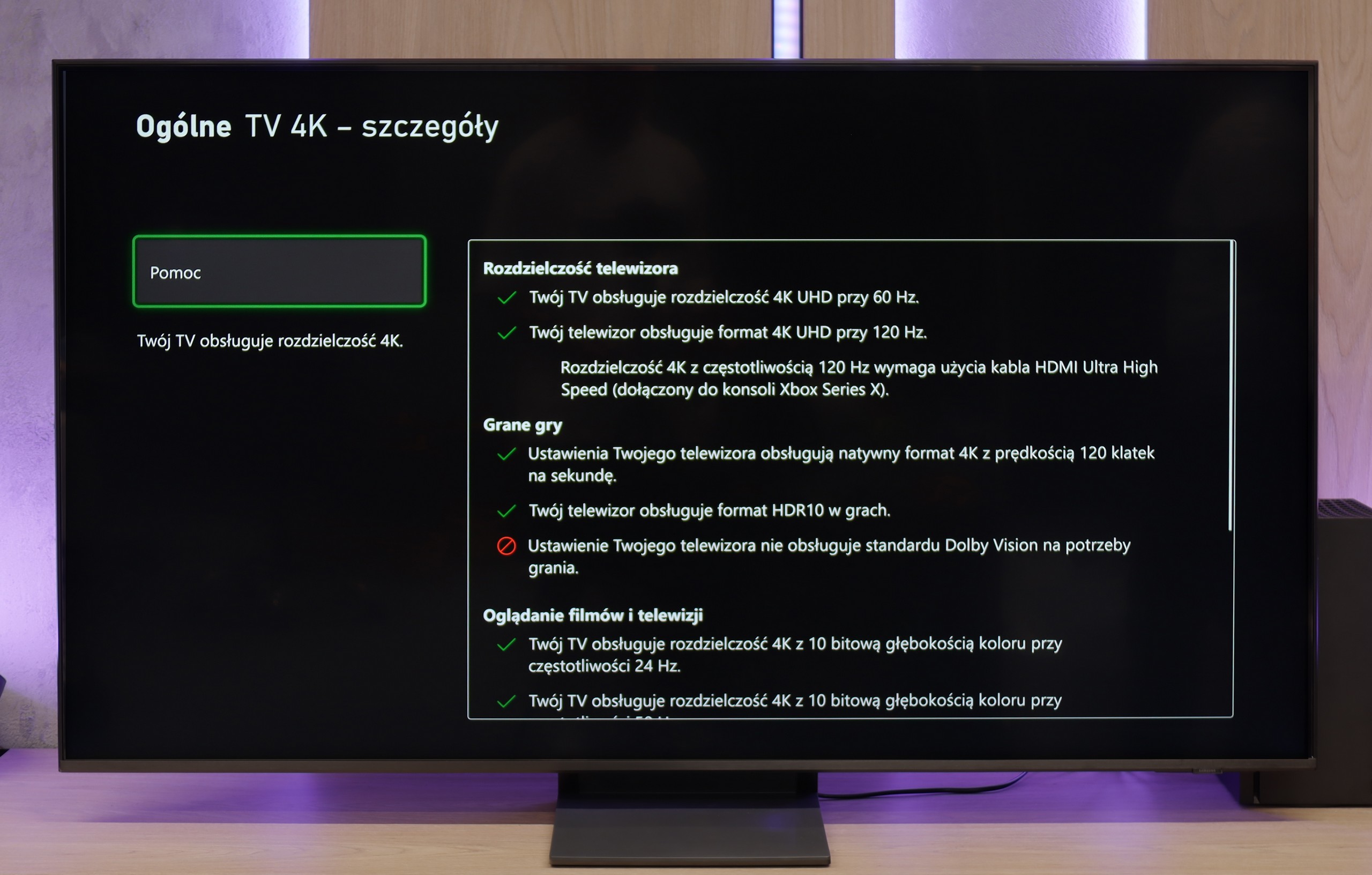

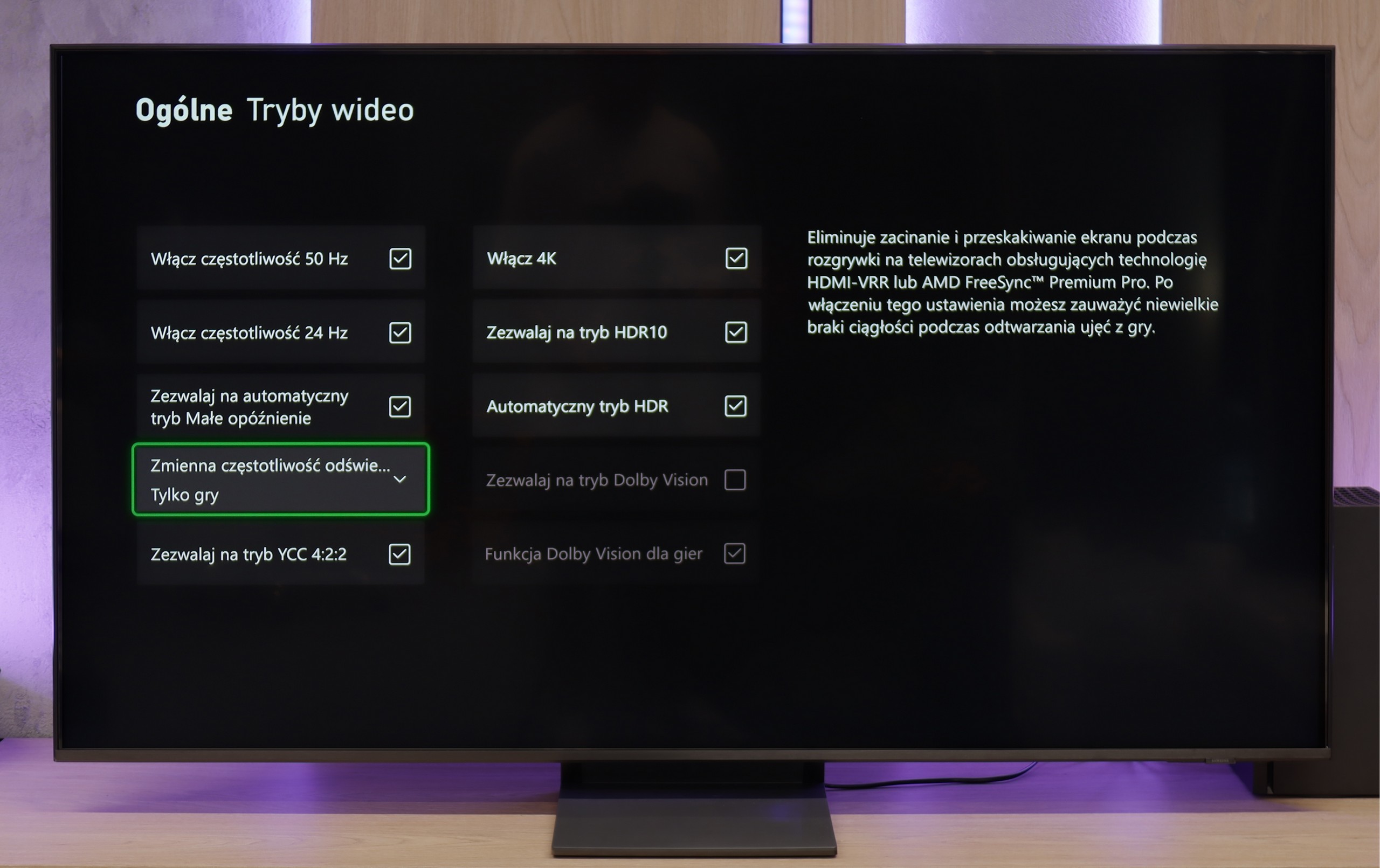
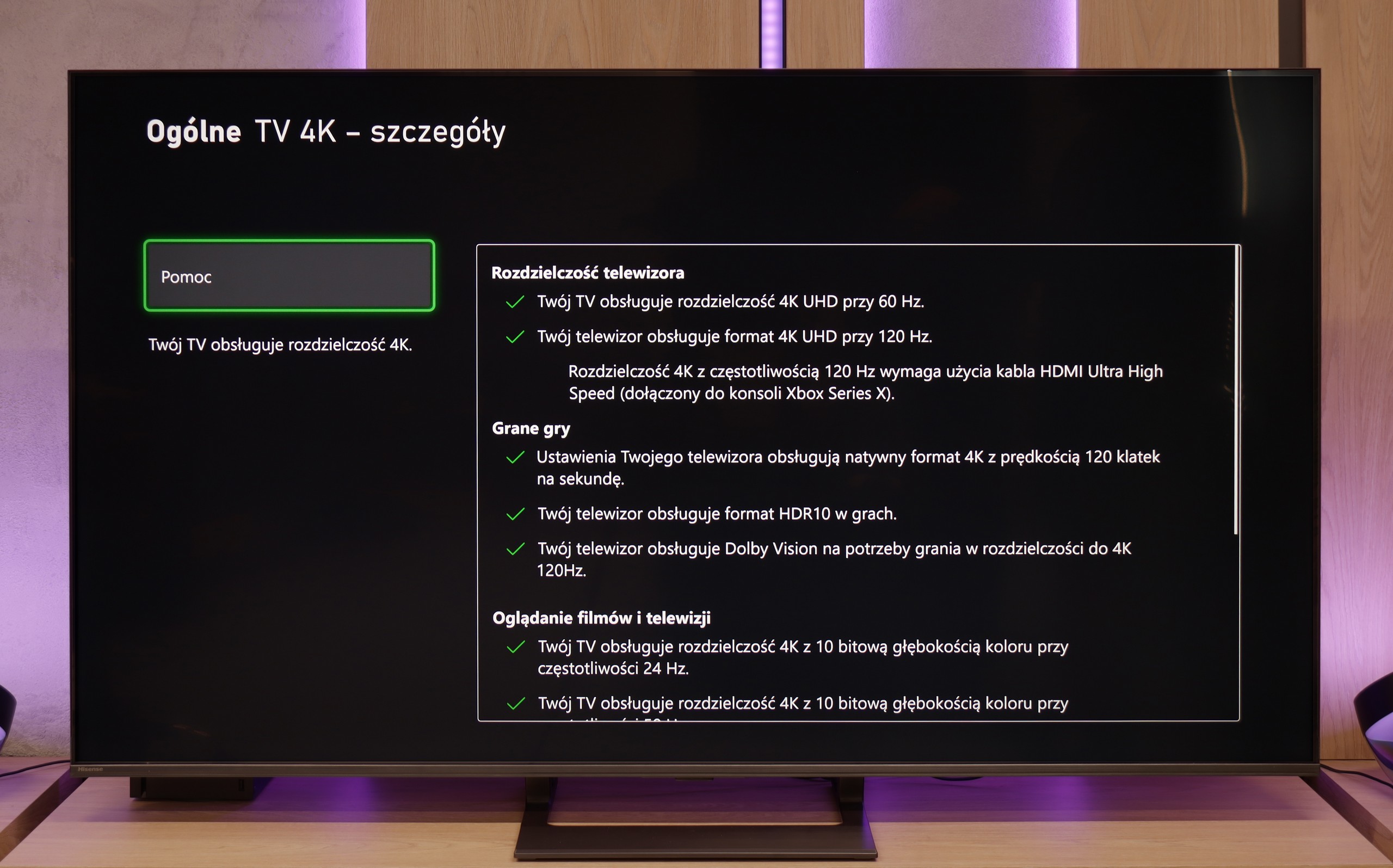
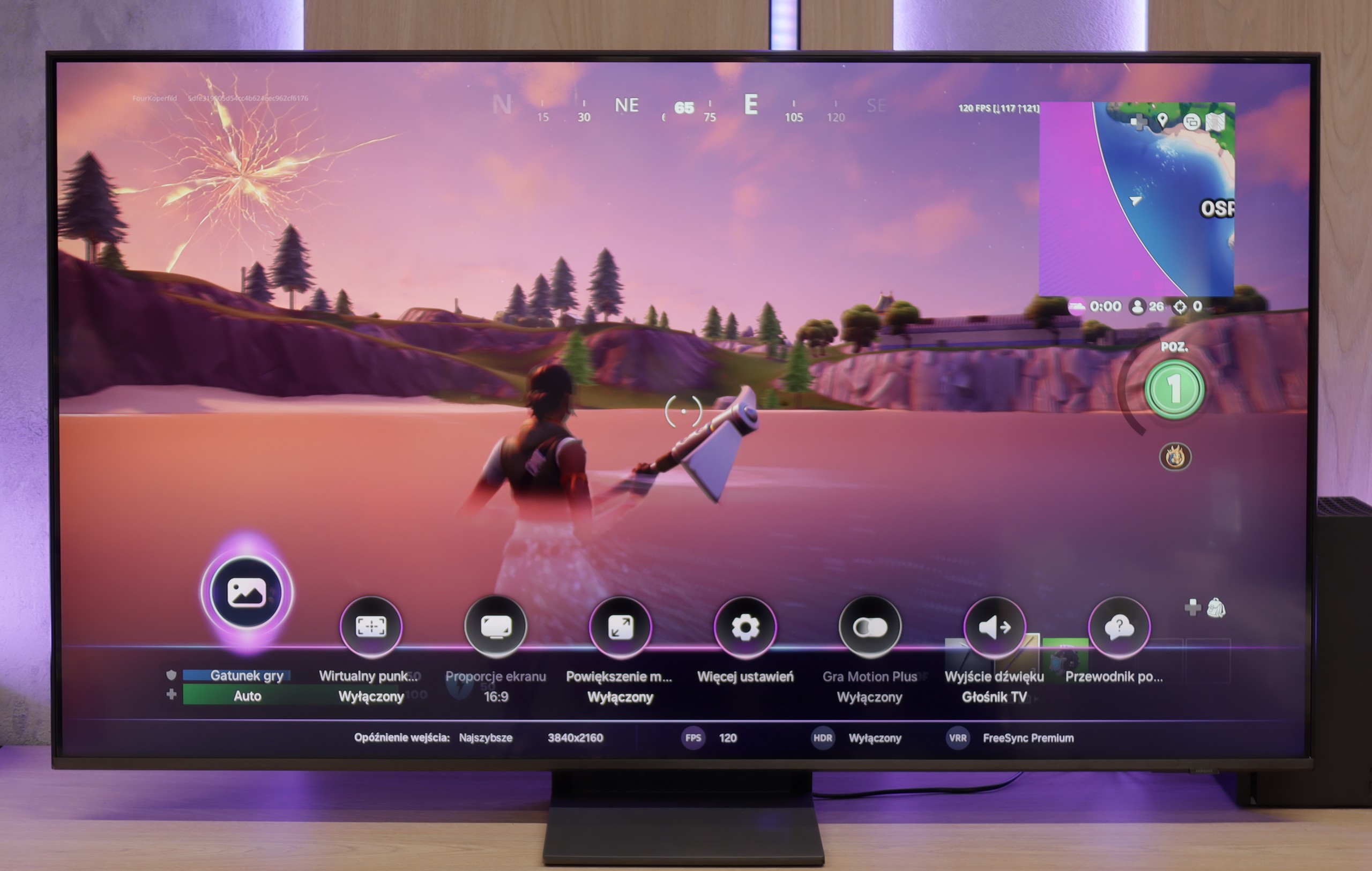
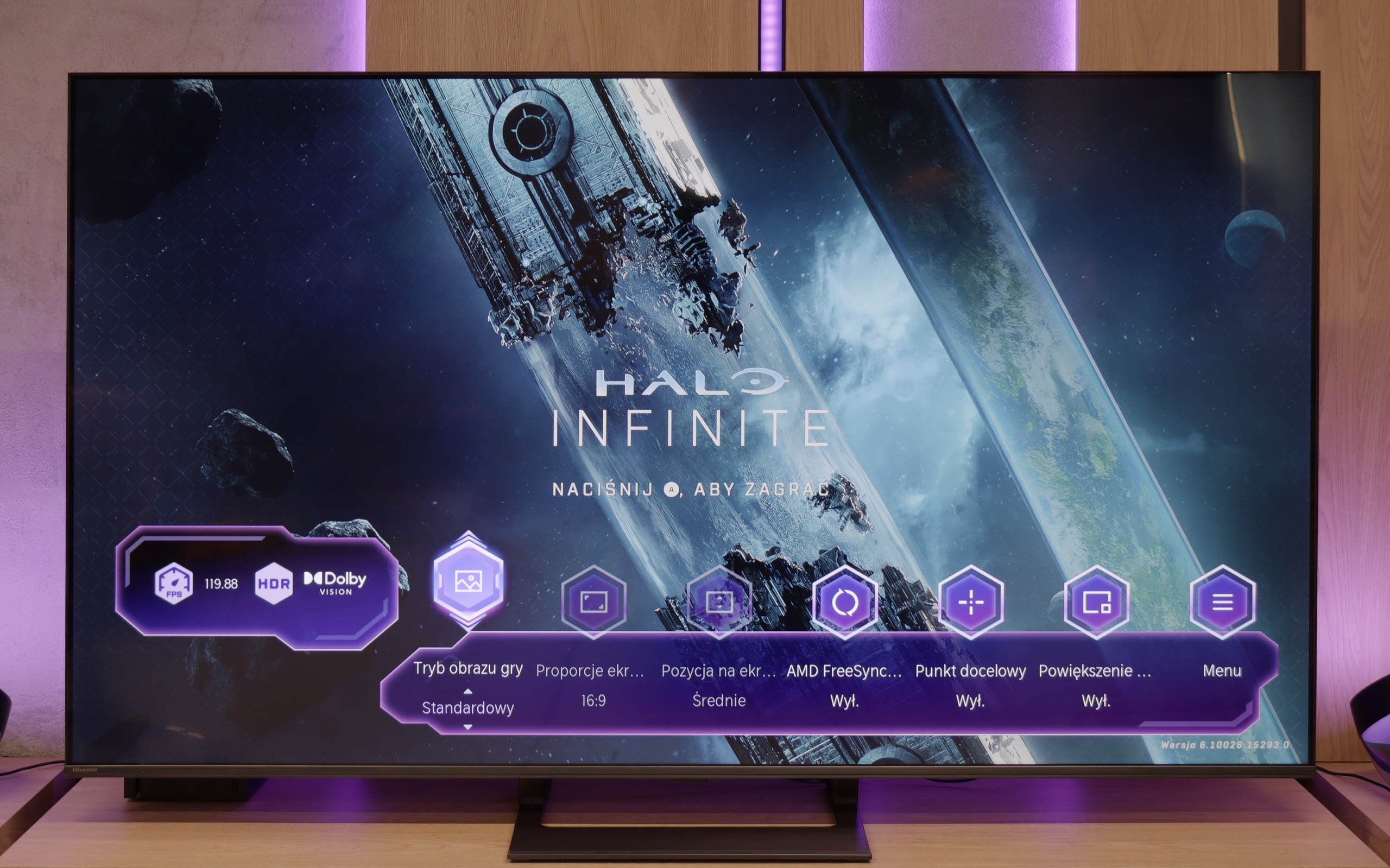
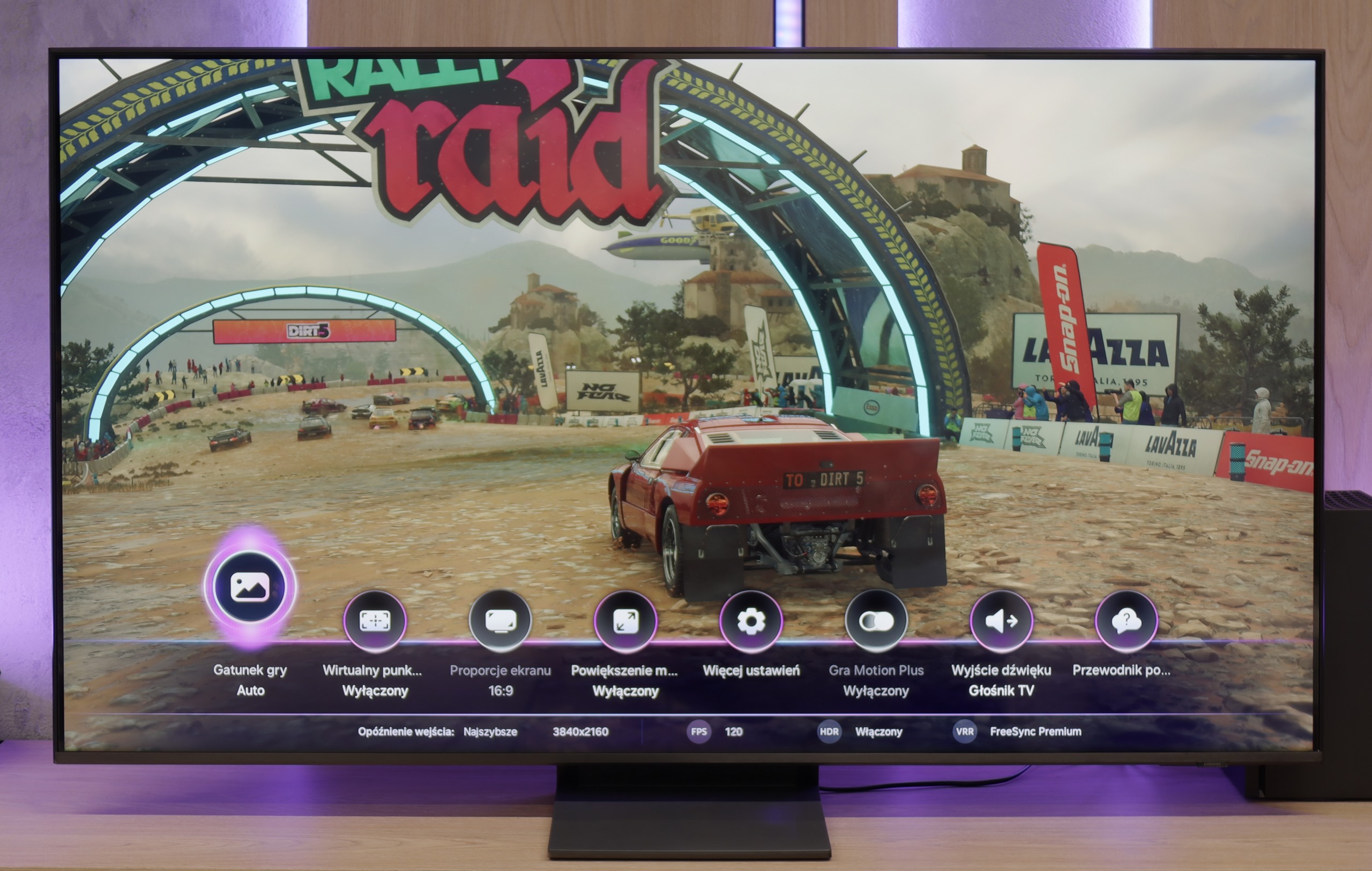

Samsung QN70F is truly a solid choice for gamers. Here we have as many as four HDMI 2.1 ports with full bandwidth of 48 Gbps, which means full support for gaming in 4K at 144 Hz refresh rate. In addition, we have all the basic features we expect today: auto low latency mode (ALLM), variable refresh rate (VRR), and a very well-designed, intuitive Game Bar with information about the mode, resolution, and frame count.
It's also worth highlighting the Game Motion Plus feature, which allows you to add artificial frames to games running at 60 fps or less. It works surprisingly well and in many titles – especially those where consoles struggle to maintain a stable framerate – it improves gameplay smoothness without significant lag.
Unfortunately, there are also some drawbacks. The lack of support for Dolby Vision mode is not surprising – it's a standard for Samsung. But the much bigger disappointment is the absence of the HGiG feature. What's worse, it was removed in a software update, leaving users who previously used it quite shocked. Without HGiG, you can't manually set the maximum HDR brightness from the console, which results in some games looking slightly washed out – especially if the TV misinterprets the tonal range. Why did Samsung, a brand that has set standards in gaming features for years, decide to take such a step? It's hard to say. At the time of writing this review, the tested TV was running on software version 1110 – and frankly, if you care about full support for gamers, it's better to temporarily hold off on updates.
The Hisense E8Q does not hide its gaming pedigree. The specification alone reveals that we are dealing with a television that will work great as a gaming screen. Variable Refresh Rate (VRR)? Yes. Automatic low latency mode (ALLM)? It's there too. Additionally, there is impressive refreshment – 120 Hz in 4K or even 240 Hz in Full HD. Such a set is rare in this price segment. Everything works smoothly and without major surprises. The only missing element – like in the U7Q – remains support for HGiG. It's a pity, because this feature makes it easier to match the brightness curve to the capabilities of a particular television, improving visual consistency with the intentions of HDR game creators. Without it, one has to manually tweak the settings, which does not always yield a satisfying result.
Input lag
10/10
9.7/10
SDR
HDR
Dolby Vision
QN70F does not disappoint in terms of response time either. For 120 Hz materials, input lag stays around 8 ms, which can be considered a very good result – especially in the context of online competition or fast-paced action games. The screen responds to controller movements almost instantly, without any noticeable delay. This allows for smooth and comfortable gameplay, even in more demanding titles. In this category, Samsung still maintains a high standard, and it’s hard to find anything that could raise concerns.
The E8Q handles delays very well. For 120 Hz content, the input lag is super low – practically unnoticeable even for more demanding gamers. At 60 Hz, the values are a bit higher, but still comfortably within the "placebo" range – there's nothing to complain about. The biggest increase in lag was noted in Dolby Vision Gaming mode. The TV needs more time to process the signal in this mode, but even then, it does not exceed 30 ms. While these may not be perfect values, they won't pose any obstacles for most gamers – especially console gamers.
Compatibility with PC
8.2/10
8.6/10
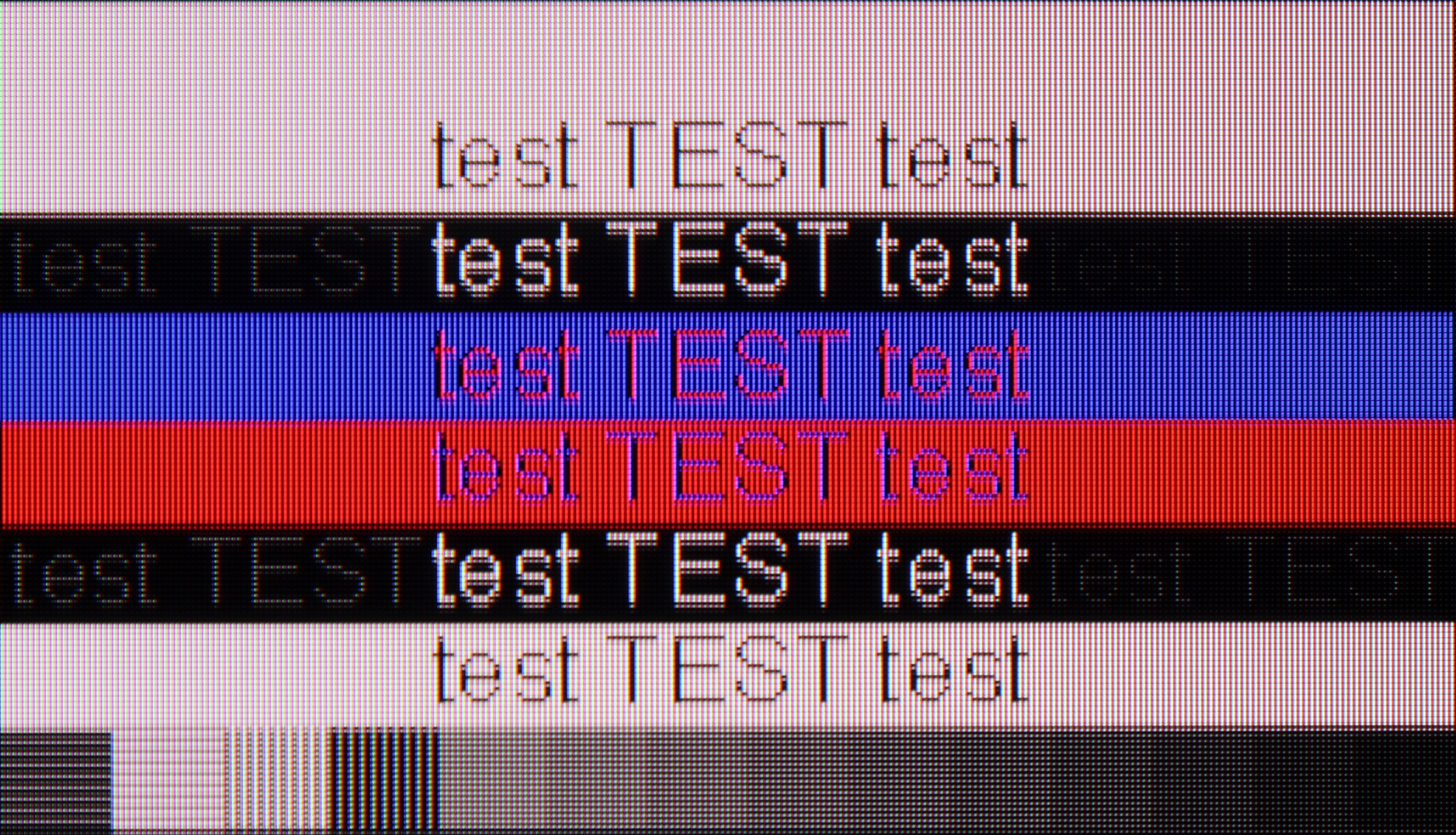

Let's start with the best aspect when it comes to connecting the QN70F to a computer – that is gaming. The 144 Hz refresh rate, support for G-Sync compatible VRR, and very low input lag are the recipe for an almost perfect screen for PC gamers. In this role, the QN70F truly does not disappoint – games look smooth, responsiveness is at a very high level, and everything operates stably.
However, the performance when it comes to text work is somewhat lacking. At a 4K resolution and 144 Hz refresh rate, there is a noticeable lack of sharpness in the text outlines – the text can appear slightly blurred, with a slight "layering" of the outlines. This is not a problem that disqualifies the usability of the QN70F as a monitor, but those planning to do office work or text editing on this screen should keep this in mind.
In terms of collaboration with the computer, the E8Q performs really well. It supports chroma 4:4:4 at full 4K resolution and at the highest refresh rate, so the readability of fonts – even the smallest ones – is at a very good level. There are minor blurriness issues with exceptionally thin fonts, but in everyday use, this is hard to consider a serious problem. A nice addition for PC gamers is the ability to achieve up to 288 Hz at lower resolutions. The E8Q communicates effortlessly with powerful graphics cards, making it an interesting choice not only for movies or consoles but also for gaming on a computer.
Viewing angles
3.1/10
3/10
As for the VA panel, the viewing angles on the QN70F are typical – meaning rather average. The image quickly loses contrast and saturation when we start looking at the screen from a sharper angle. Compared to IPS panels, it's definitely weaker. On the other hand – it is precisely because of this panel that we gain better black levels and higher contrast when viewing straight on, which for many users will be more important than wide visibility from the sides.
E8Q, like most TVs with a VA panel, looks best when we sit directly in front of the screen. In this position, one can count on deep blacks, good color saturation, and high contrast. Unfortunately, just moving slightly to the side causes the picture quality to suffer – colors start to fade, and blacks become more gray than black. This isn't surprising, but it's worth keeping in mind, especially if we plan to watch in a larger group from different positions in the living room. As a consolation – in return, we get significantly better black levels than with IPS panels.
TV efficiency during daytime
6.3/10
6.2/10
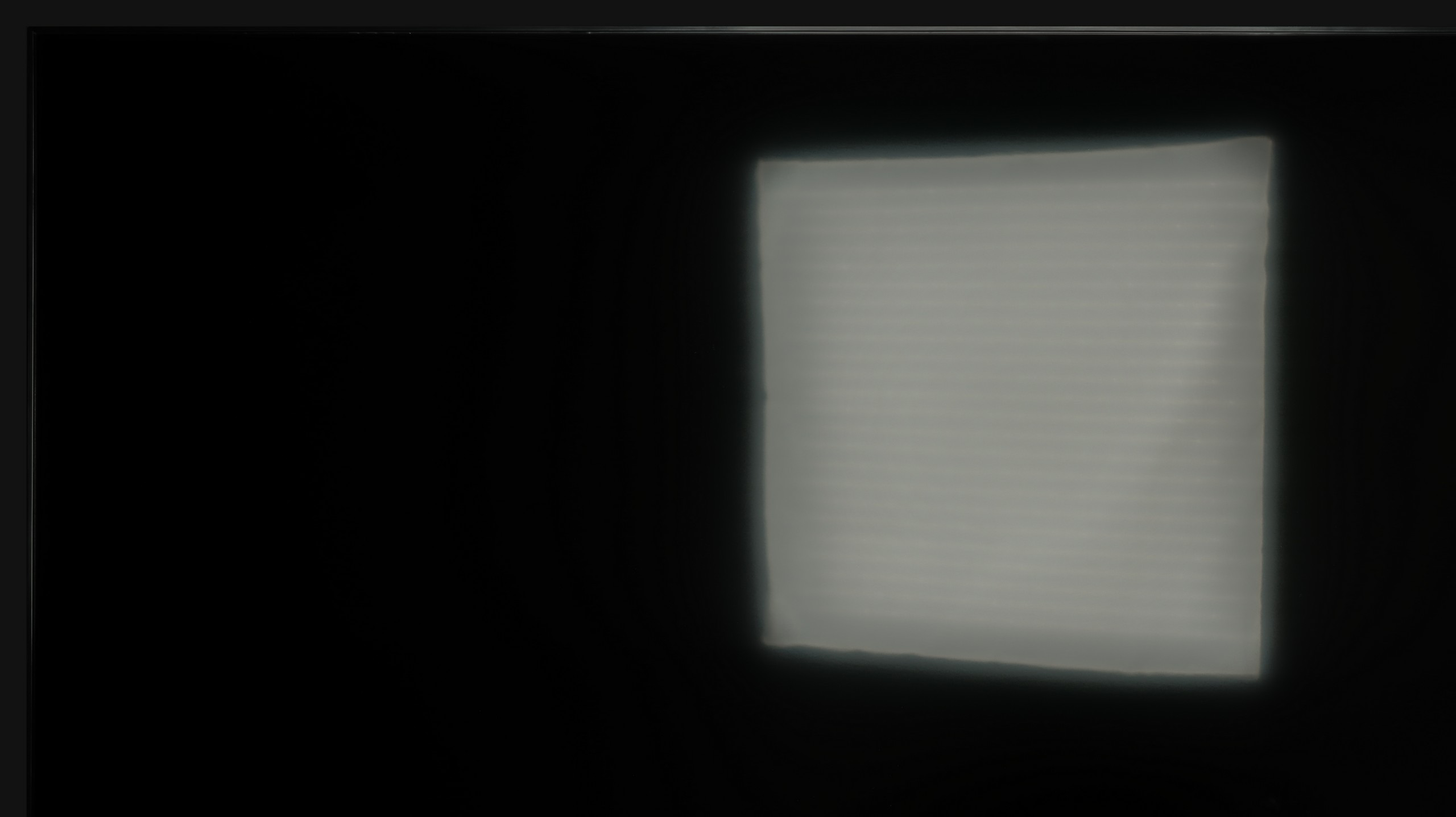



Matrix brightness
Average luminance SDR
Hisense E8Q: 504 cd/m2
Samsung Neo QLED QN70F / QN74F / QN77F: 492 cd/m2
The QN70F handles a bright living room without any problems. The screen has a satin finish that effectively reduces reflections, so there's no need to immediately draw the curtains to see something. Even when there’s a lot of light in the room – for example, near a window on the side – the image still looks sharp and colorful. Brightness is also at a solid level. In SDR mode, the television averages around 500 nits, which is more than enough for daytime viewing. It may not be at the level of top models, but in practice – for everyday watching of TV, sports, or YouTube – it performs very well.
The Hisense E8Q is not afraid of bright interiors. Even when the full sun is shining outside, the television can maintain good image clarity. A brightness level of around 500 nits ensures that you can comfortably watch content during the day, without feeling that everything is drowning in glare. The satin screen coating also helps to pleasantly reduce reflections – it doesn't eliminate them completely, but limits them enough that they don't interfere with everyday viewing.
Details about the matrix
Subpixel Structure:
Panel uniformity:
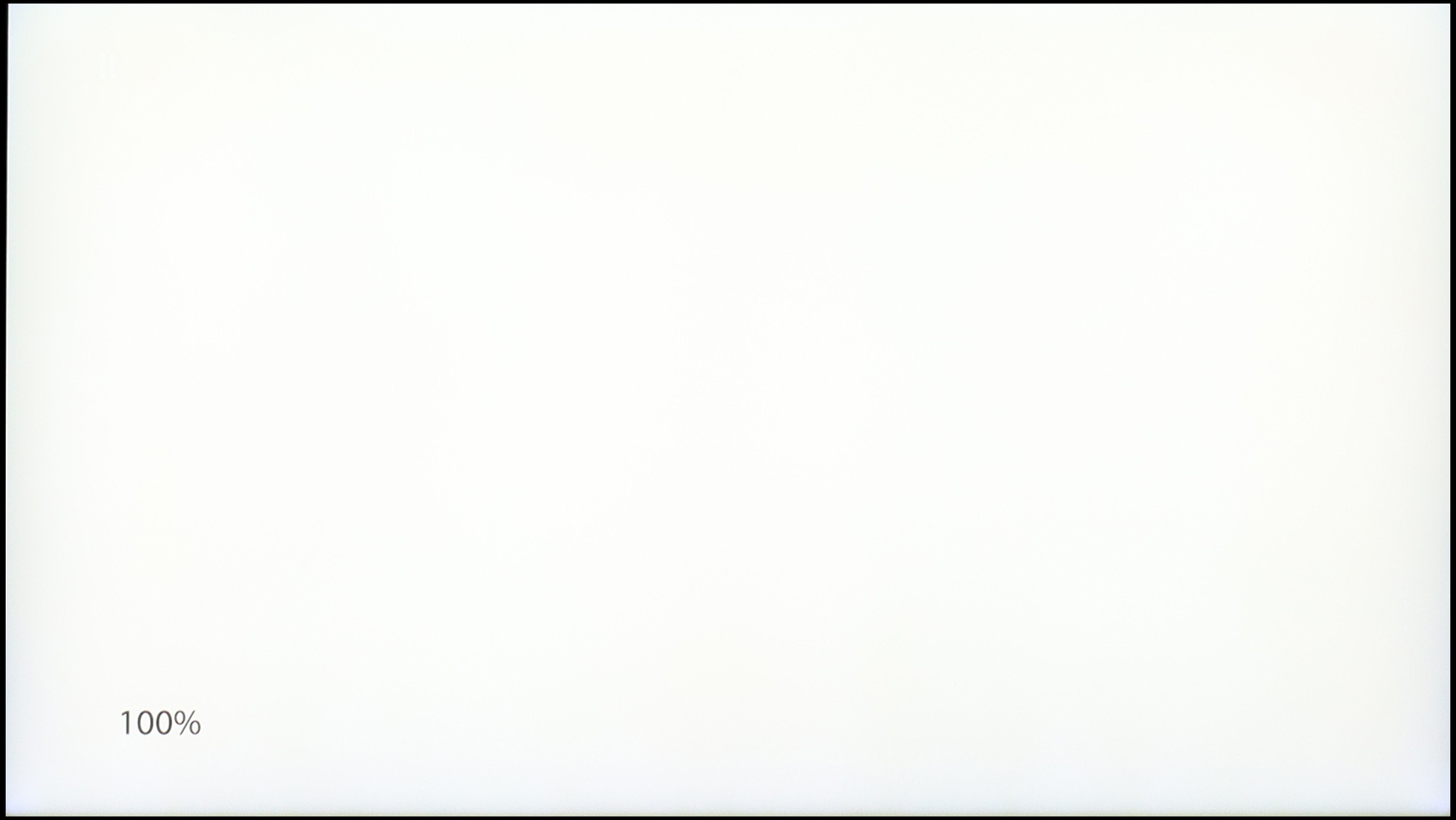
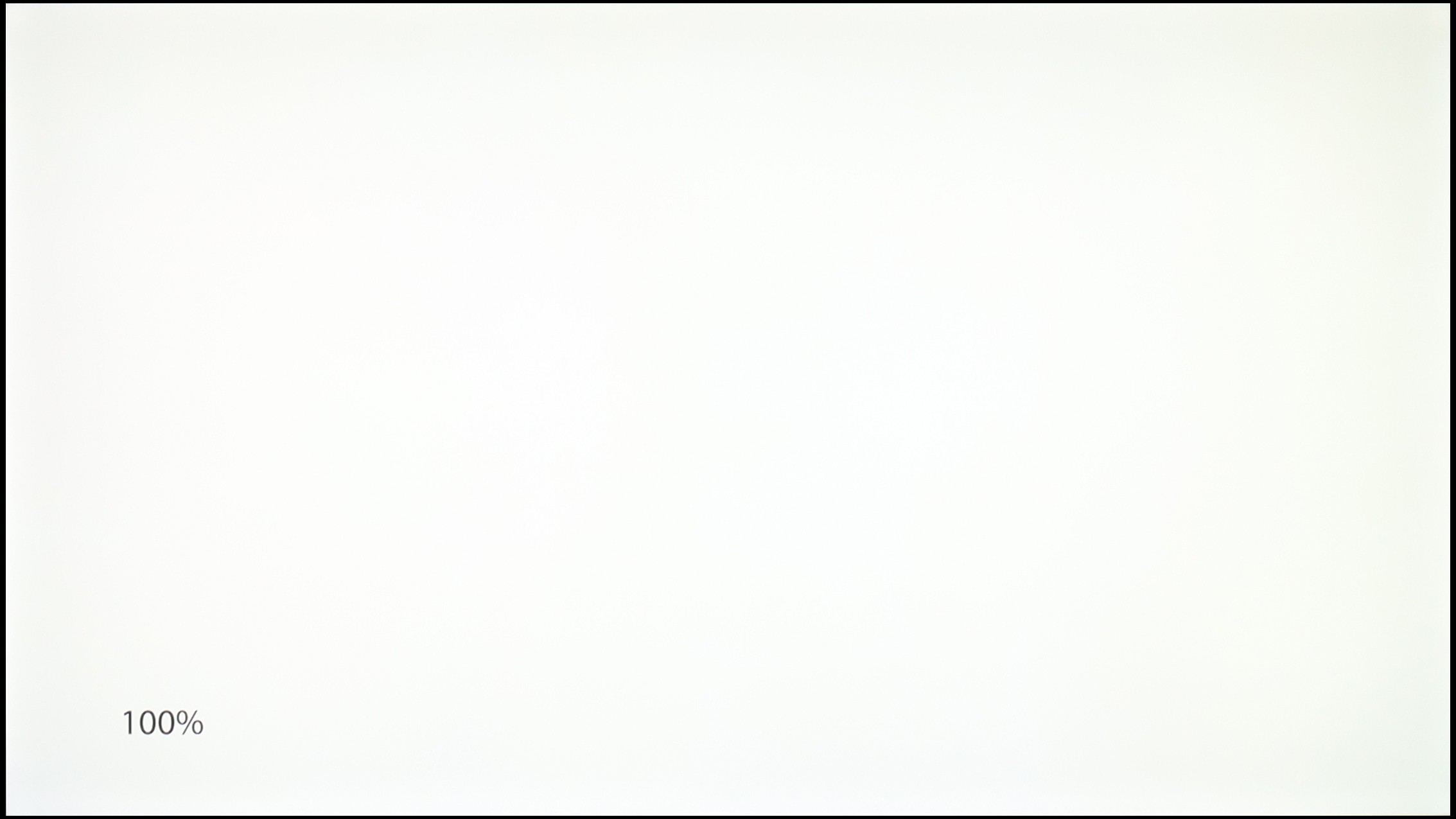
Samsung Neo QLED QN70F / QN74F / QN77F
Hisense E8Q
TV features
7.5/10
8.9/10
- HDMI inputs0 x HDMI 2.0, 4 x HDMI 2.1 48Gbps2 x HDMI 2.0, 2 x HDMI 2.1 48Gbps
- Other inputsRCA (Chinch)
- OutputsToslink (Optical audio), eARC (HDMI), ARC (HDMI)Toslink (Optical audio), eARC (HDMI), ARC (HDMI), Mini-Jack (Headphones)
- Network InterfacesWi-Fi 2.4GHz, Wi-Fi 5GHz, Ethernet (LAN) 100MbpsWi-Fi 2.4GHz, Wi-Fi 5GHz, Ethernet (LAN) 100Mbps
- TV receptionDVB-T, DVB-T2, DVB-S, DVB-S2, DVB-CDVB-T, DVB-T2, DVB-S, DVB-S2, DVB-C
Classic features:
- Recording to USB (terrestrial TV)
- Recording programming
- Picture in Picture (PiP)
- RF remote control (no need to aim at the screen)
- Backlit remote control
- Teletext
- Audio only mode
- Possibility to connect Bluetooth headphones to the TV
- Possibility to simultaneously use Bluetooth headphones and the TV speaker
Smart features:
- AirPlay
- Screen mirroring (Windows Miracast)
- Wyszukiwanie głosowe
- Voice search in native language
- Ability to connect a keyboard and mouse

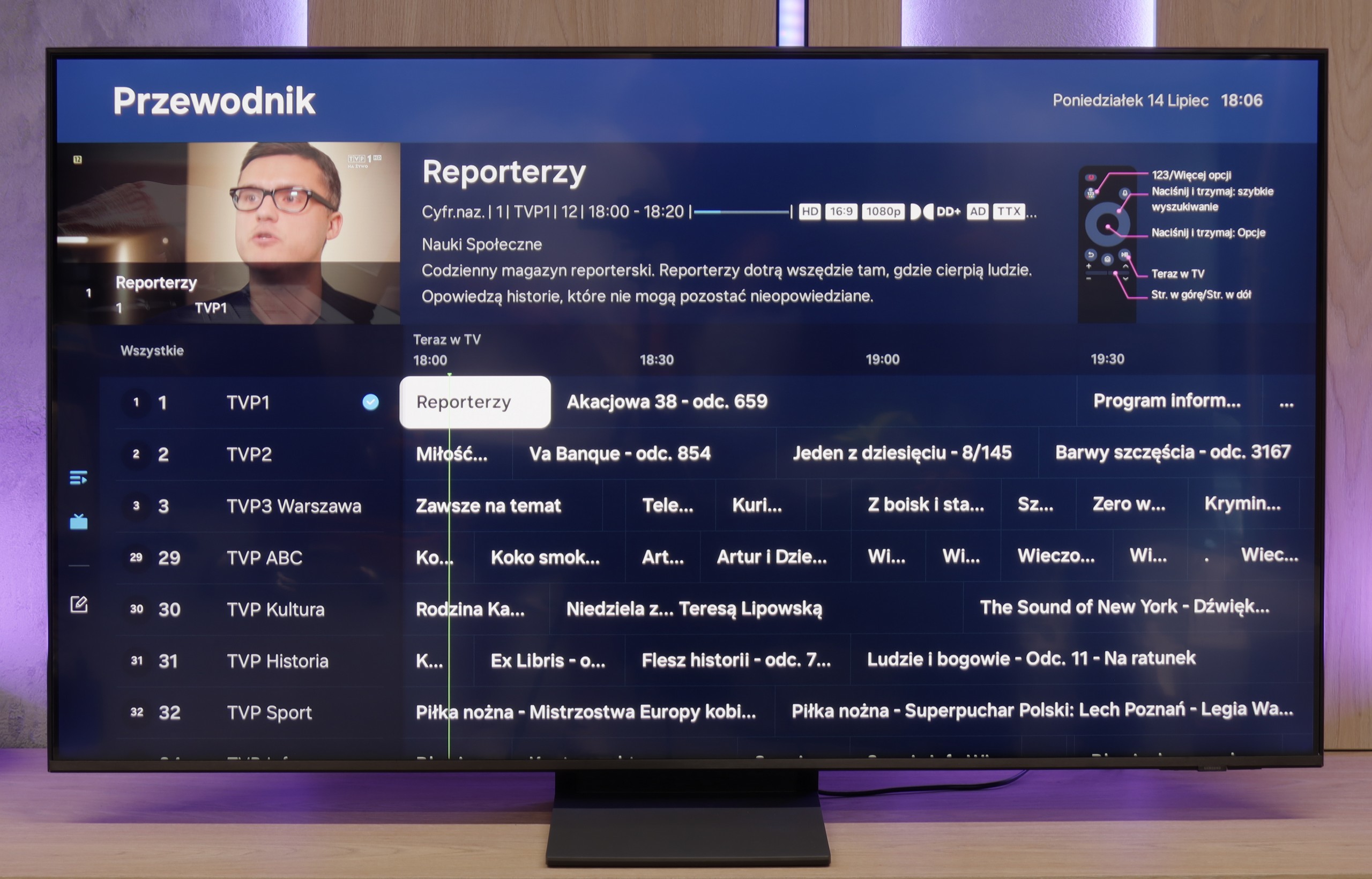
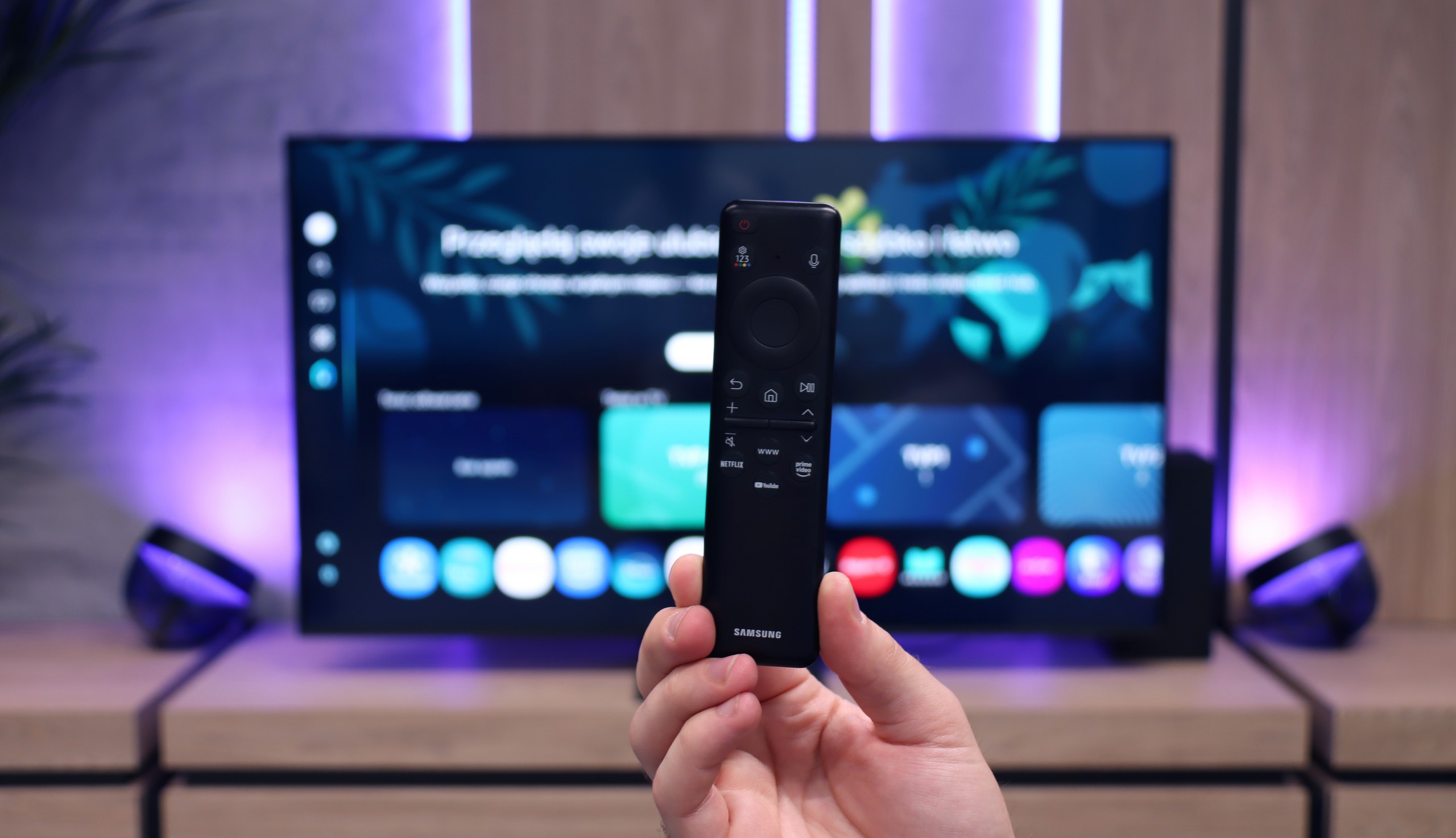
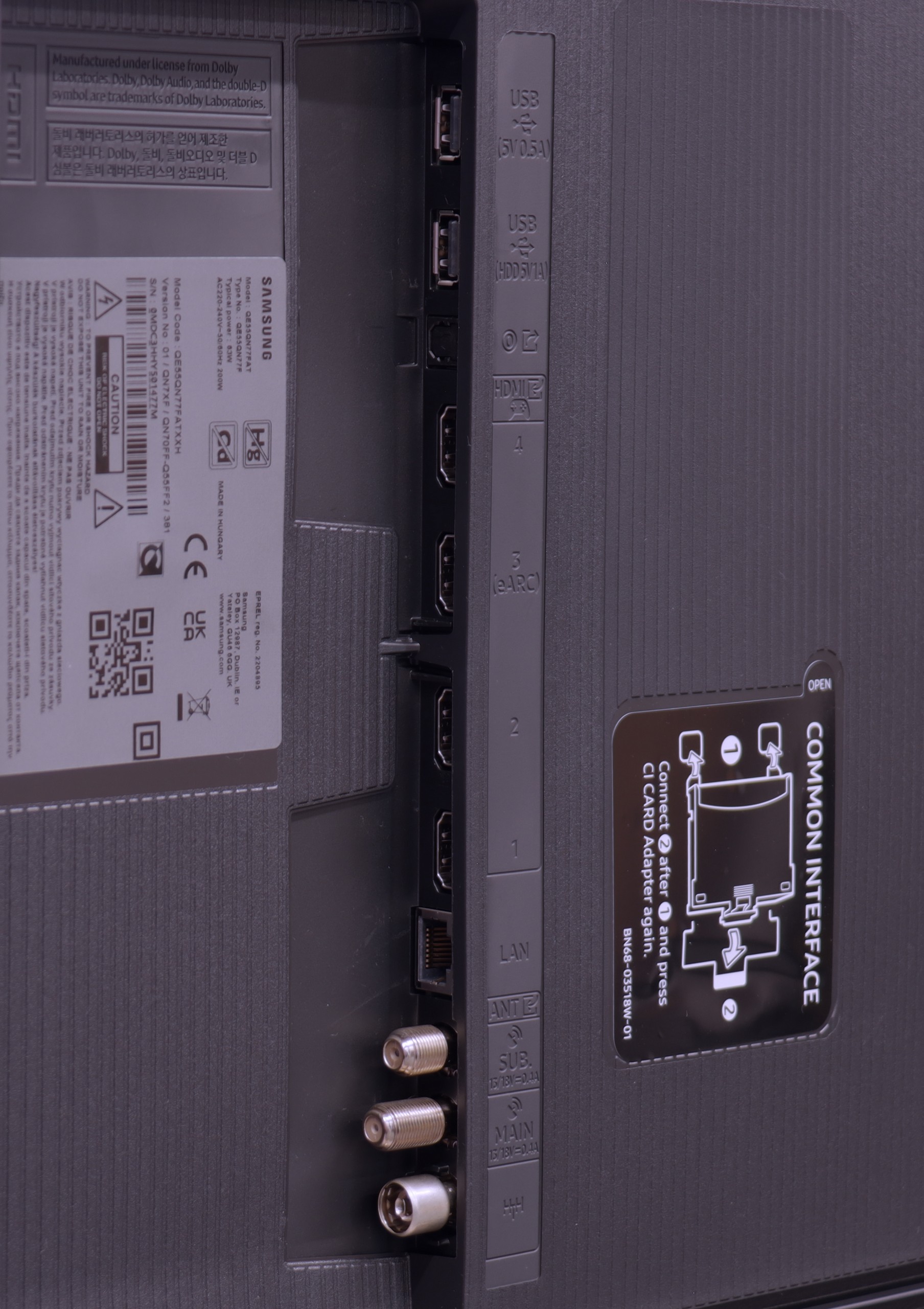
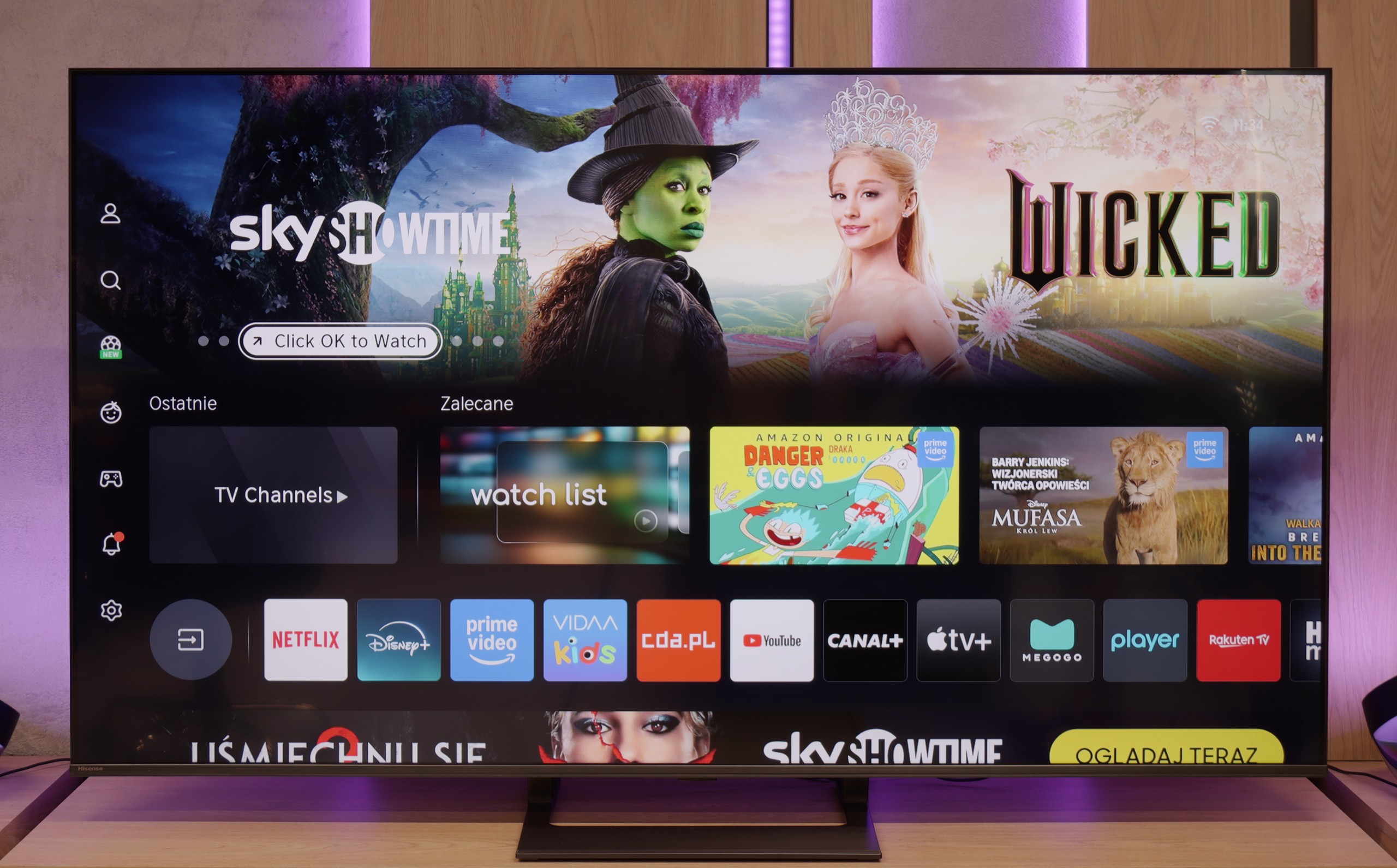
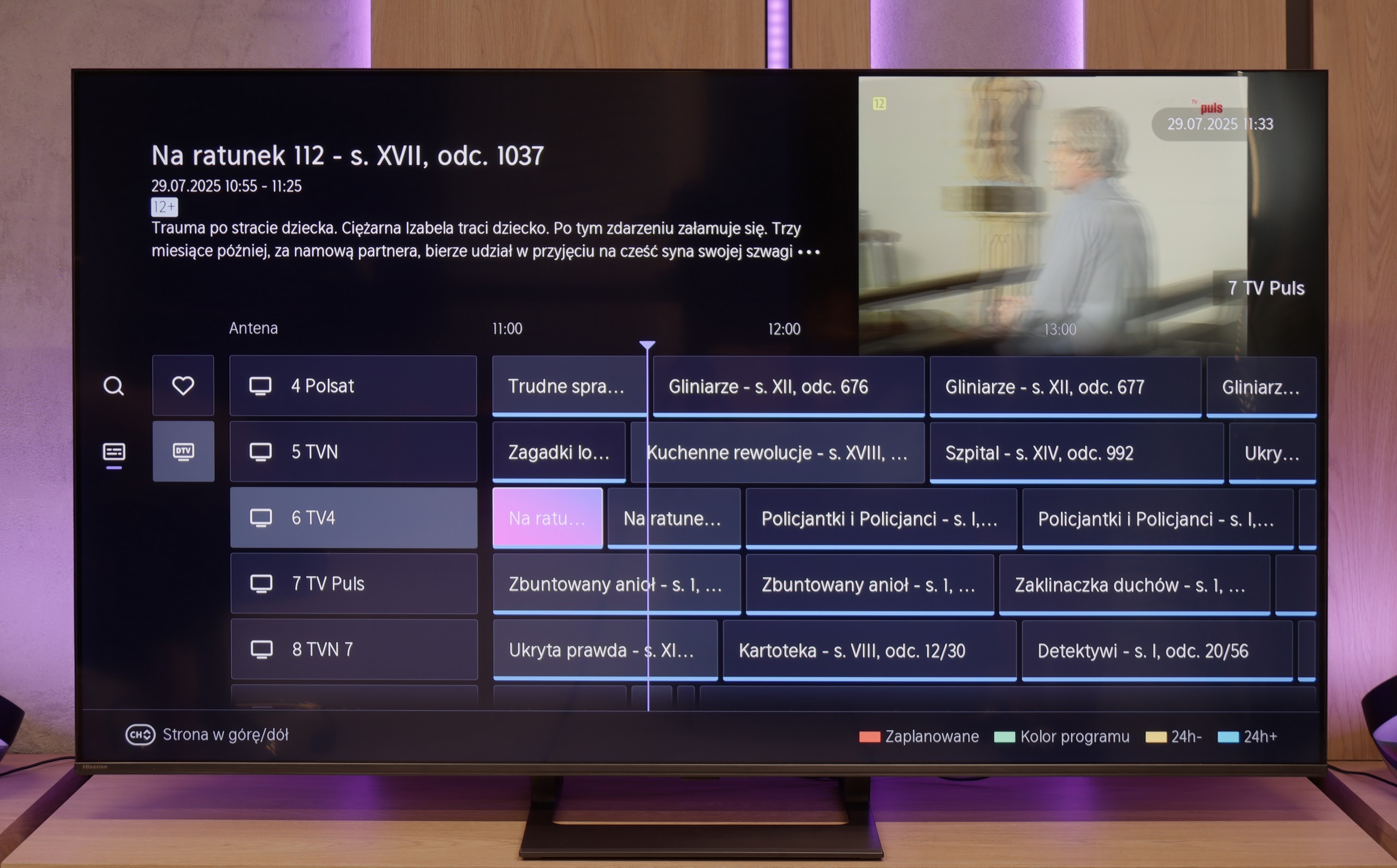


TV Features
The QN70F does not forget about classic features that still matter to many users. On board, we find, among other things, picture-in-picture mode (PiP), enabled by the presence of two tuners, teletext, and "Audio Only" mode – ideal if we want to use the TV like a radio. We can effortlessly pair it with headphones or a soundbar via Bluetooth, and the remote – despite the lack of a numeric keypad – works reliably, allowing control of other devices and additionally does not require us to aim at the screen. However, it should be noted that, as with all new Samsung models, we will not find USB recording functionality here. This is a system limitation that the brand consistently adheres to.
Smart TV QN70F – Tizen
The Tizen system, developed by Samsung for years, is one of the most refined Smart TV interfaces. It is fast, clear, and feature-rich. The QN70F supports voice search (also in Polish), wireless screen sharing from a phone (both via AirPlay and Miracast), as well as integration with watches and other devices in the Samsung ecosystem. All of this is connected by the SmartThings app, which allows controlling devices, automating tasks, and connecting devices on one network. (Not only Samsung brand). However, it is not perfect. Tizen is a closed system, so the selection of applications can be somewhat limited – especially compared to Google TV. All the major streaming services are in place, but if you use less popular services, it's worth checking before purchase whether they are available in the Samsung store.
Classic Features – E8Q
The Hisense E8Q is not only equipment for gamers or movie enthusiasts – it can also serve as a daily television for the entire family. We can record programs to USB, connect headphones or speakers via Bluetooth, and the entire interface – including the channel guide – is clear and easy to use. It only lacks the PiP function, but aside from that, the set of classic features is truly complete.
Smart TV – VIDAA System
The E8Q runs on the VIDAA system, which is becoming more refined year by year. Voice search in Polish works flawlessly, and it's easy to cast from your phone (AirPlay and screen mirroring). The system operates smoothly, without any hiccups, although – as is often the case with closed platforms – there may occasionally be one or two less popular apps missing. Therefore, it’s worth checking before purchase to see if everything we use daily is available there.
Playing files from USB
8.4/10
8.2/10
Supported photo formats:
Maximum photo resolution:
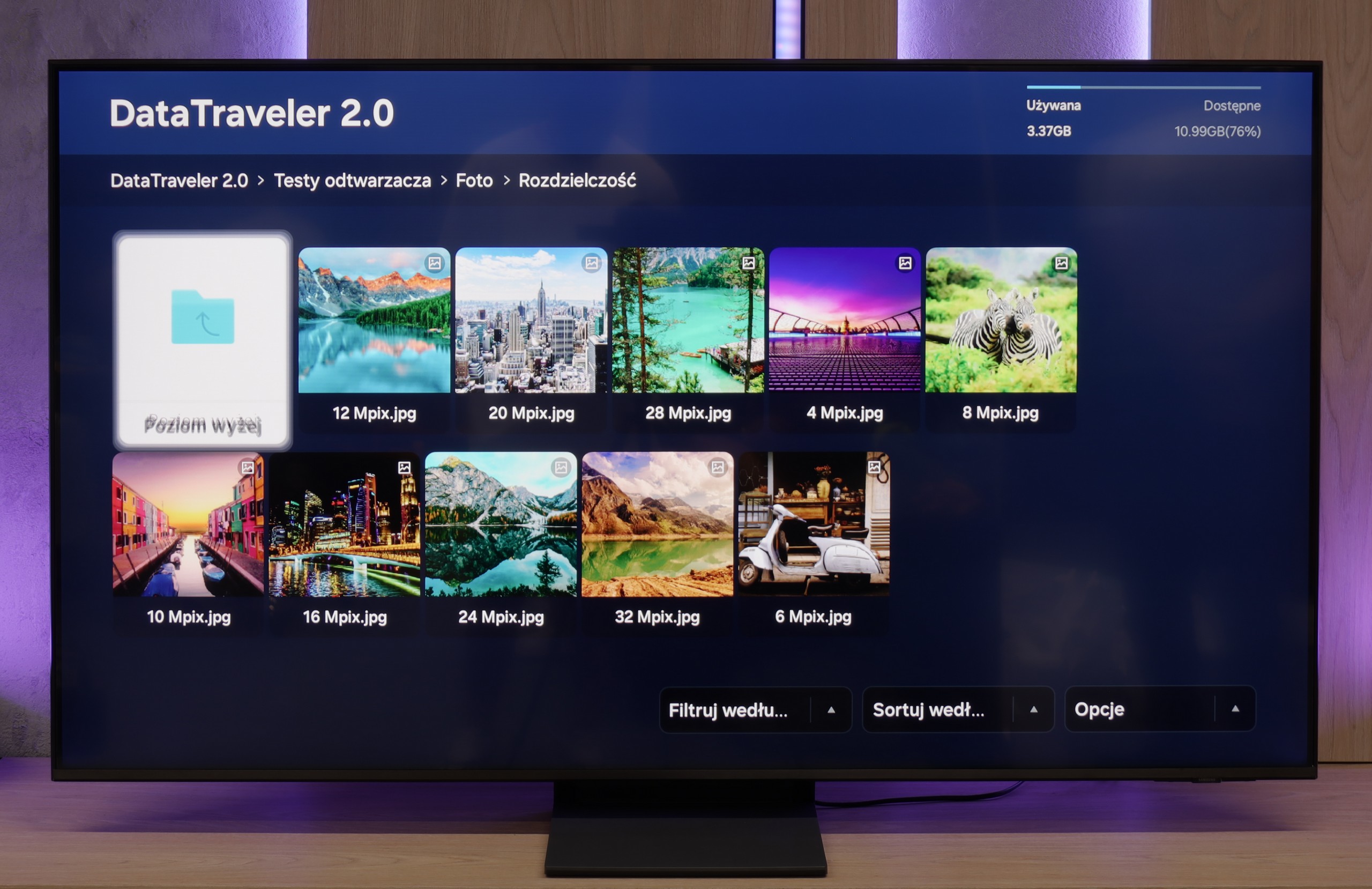
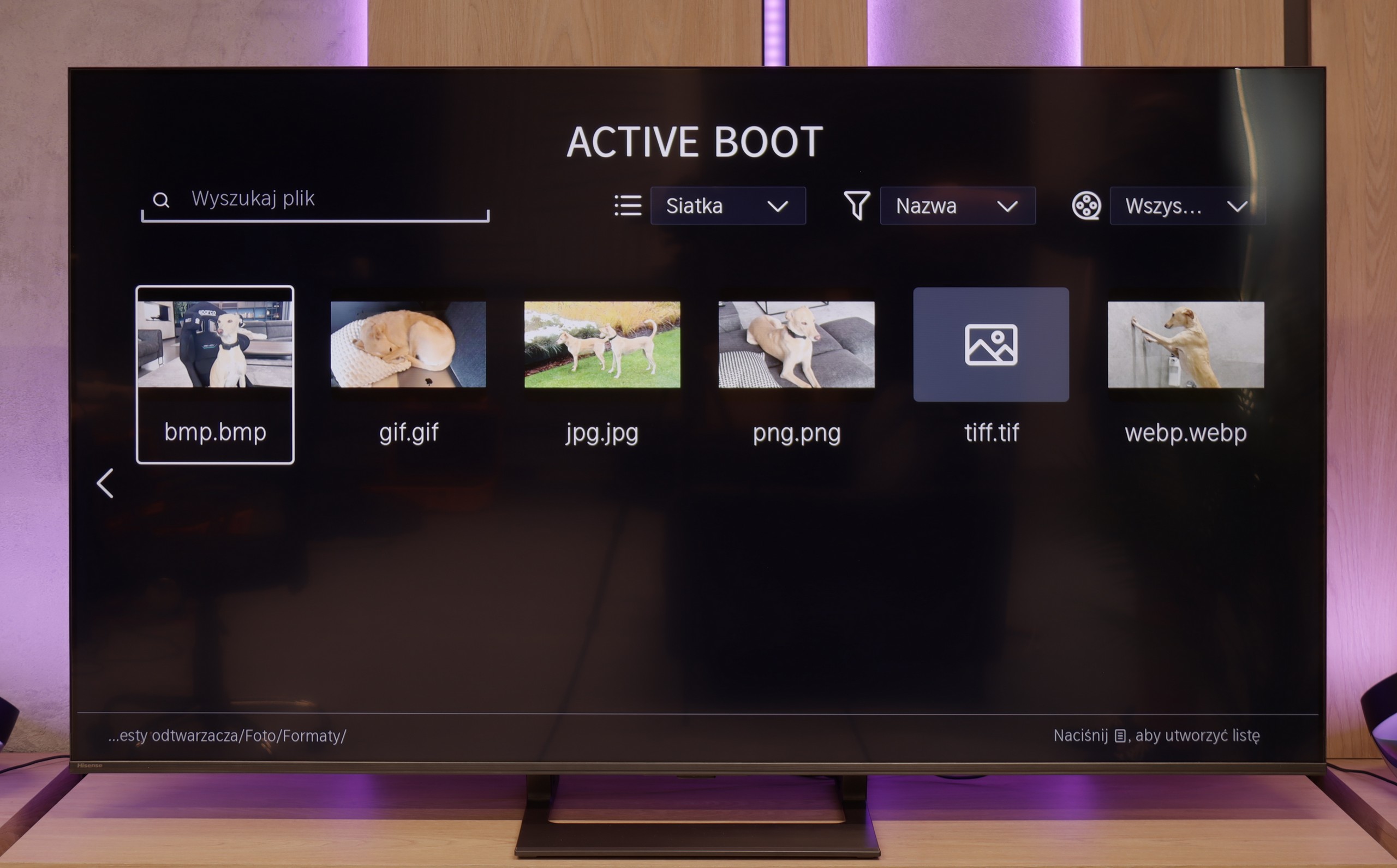
Samsung QN70F performs well in media playback – it easily runs pictures, music, and videos in the most commonly used formats. During testing, it opened JPG files, MP4, and TXT subtitles without any trouble, so for most people, this will simply be sufficient. However, there were a few files – despite having the correct extensions – that refused to play. It may be an issue with a specific version of the system, and the problem might disappear after future updates.
The built-in media player in E8Q performs quite well. It supports most popular video and audio formats, and files from USB drives or external disks play without major issues. Polish characters? They are supported. Subtitles? They work. The only minor drawback is the occasional problem with displaying high-resolution images – especially those from cameras or smartphones. So if you plan to show vacation photos on a large screen, it’s worth checking in advance whether they will all load correctly from the drive’s memory or USB stick.
Apps
8.7/10
7.7/10














































Sound
6.4/10
5.5/10
- Subjective sound quality:6.4/105.5/10
- Dolby Digital Plus 7.1:
- Dolby True HD 7.1:
- Dolby Atmos in Dolby Digital Plus (JOC):
- Dolby Atmos in Dolby True HD:
- DTS:X in DTS-HD MA:
- DTS-HD Master Audio:
The Samsung QN70F is quite average in terms of sound, which shouldn't be surprising given the exceptionally slim design of the television. The built-in speakers will perform adequately during daily news watching or simpler content, but it's hard to speak of any depth or spaciousness of sound here. It's simply a compromise that one has to accept when choosing an elegant and thin design over a bulkier housing with a better audio system.
Unfortunately, the Hisense E8Q did not leave the best impression on us. Although on paper it has speakers with a power of 40 W (which is only slightly less than the 50 W in the U7Q), in practice, the difference is significant—and unfortunately not in favor of the E8Q. During testing, it quickly became apparent that something was off. When the volume was raised above 40-50%, the entire back housing began to resonate, and unpleasant crackling sounds emerged from the television. Even during regular viewing, it was hard not to notice this, and definitely hard not to hear it. In this form, it is difficult to talk about listening comfort. We do not rule out that this was a problem with a specific test unit, but nonetheless—it is worth keeping this in mind. If good sound is important to you, consider connecting a soundbar or… stick with the U7Q, which performs significantly better.


